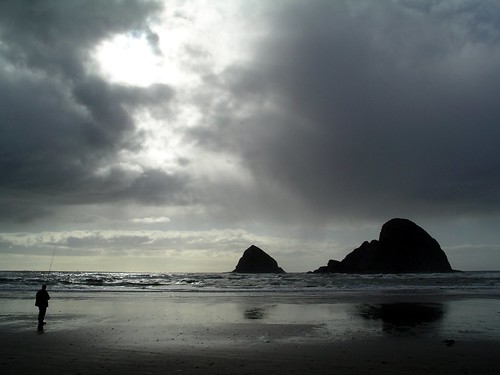Wednesday, February 28, 2007
Oregon fly fishing show season begins
Oregon Fly Fishing Shows: The timing is about right. It's late in the winter steelhead run, early in the spring trout season. Sure there are fish biting somewhere, but it's snowing and the water is high.
Back on February 17-18, 2007, The Fly Fishing Show came to Portland, OR at the Oregon Convention Center. Chester Allen, a writer for The Olympian, had a great write up of the event.
From the article: "Hordes of fly anglers herded themselves right into the Oregon Convention Center and forked over 24 bucks for two days inside a building that has all the charm and intimacy of an international airport."
That show has come and gone, but the new show on the block is around the Corner. The Northwest Fly Tyers and Fly Fishing Expo 2007 is going to be March 9 and 10 at the Linn County Expo Center in Albany, Oregon. It's run by the same group that put on the Fly Tyer's expo in Eugene in previous years.
The NW Fly expo is being put on by the Federation of Fly Fishers. Oregon Outdoor Journal will be on premises at the event, volunteering to run a booth for Eugene Trout Unlimited Chapter 678.
We'll have a full report from the show right here.
Also, I'm headed to Houston and Orlando this week -- talking about energy efficiency and technology. But not much about the Oregon Outdoors. But if something comes up, I'll post.
Back on February 17-18, 2007, The Fly Fishing Show came to Portland, OR at the Oregon Convention Center. Chester Allen, a writer for The Olympian, had a great write up of the event.
From the article: "Hordes of fly anglers herded themselves right into the Oregon Convention Center and forked over 24 bucks for two days inside a building that has all the charm and intimacy of an international airport."
That show has come and gone, but the new show on the block is around the Corner. The Northwest Fly Tyers and Fly Fishing Expo 2007 is going to be March 9 and 10 at the Linn County Expo Center in Albany, Oregon. It's run by the same group that put on the Fly Tyer's expo in Eugene in previous years.
The NW Fly expo is being put on by the Federation of Fly Fishers. Oregon Outdoor Journal will be on premises at the event, volunteering to run a booth for Eugene Trout Unlimited Chapter 678.
We'll have a full report from the show right here.
Also, I'm headed to Houston and Orlando this week -- talking about energy efficiency and technology. But not much about the Oregon Outdoors. But if something comes up, I'll post.
Monday, February 26, 2007
Oregon Wildlife frolics in Columbia Gorge
Driving back from Eastern Washington today, we came over on 84 West, through the Columbia River Gorge. As we were driving, I spotted my first herd of Oregon bighorn sheep, halfway up a cliff just a few miles east of the mouth of the John Day River. Here are some Oregon Bighorn Sheep Links:
Bighorn sheep in Hell's Canyon
Foundation for North American Wild Sheep
Oregon Bighorn Sheep statistics

Speaking of bighorns: If you're looking for an amazing, lyrical book about wildlife management, wild animals and our relationship to the wilderness, I highly reccomend Ellen Meloy's Eating Stone.
After that, KP and I stopped by Multnomah Falls and took the obligatory shot you see below:
Then on the way out of Multnomah Falls we saw a bald eagle, right on the side of 84. Maybe Steven Jr?

Speaking of bighorns: If you're looking for an amazing, lyrical book about wildlife management, wild animals and our relationship to the wilderness, I highly reccomend Ellen Meloy's Eating Stone.
After that, KP and I stopped by Multnomah Falls and took the obligatory shot you see below:
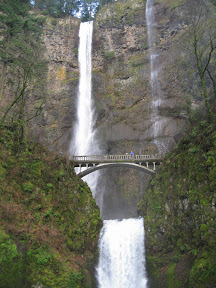 |
| From MattStansberry |
Then on the way out of Multnomah Falls we saw a bald eagle, right on the side of 84. Maybe Steven Jr?
Sunday, February 25, 2007
Oregon Cascades Snowshoeing: Highway 242
My buddy Peter Green, chairman of trail maintenance for the Obsidians, sent OOJ these photos from a recent snowshoeing trip up McKenzie Pass -- Highway 242.
The route was 14 miles round trip from the snow gate on the Sisters side of 242. Peter and his wife Monica camped on Feb 2, woke up the next day, and hiked to the summit of McKenzie Pass in about 3 hours.
They camped out in the Dee Wright Observatory. Peter had never heard of anyone camping in that shelter before, but thought it seemed like a good idea. They actually had to set up the tent inside because it was pretty wet and icy. But it was a great wind block. Lots of mice, so secure your food if you go.
Check out our audio-cast on snowshoeing with Peter Green of the Obsidians: Download MP3.
The route was 14 miles round trip from the snow gate on the Sisters side of 242. Peter and his wife Monica camped on Feb 2, woke up the next day, and hiked to the summit of McKenzie Pass in about 3 hours.
They camped out in the Dee Wright Observatory. Peter had never heard of anyone camping in that shelter before, but thought it seemed like a good idea. They actually had to set up the tent inside because it was pretty wet and icy. But it was a great wind block. Lots of mice, so secure your food if you go.
Check out our audio-cast on snowshoeing with Peter Green of the Obsidians: Download MP3.
Deschutes River February hike
Lower Deschutes River Hike: KP and I headed east today, on our way to Richland, Wash. (on a road trip for the day job). It was our first time through the Columbia River Gorge area. That drive gives you perspective on the lay of the water in our state, passing over the mouth of the Deschutes and the John Day.
We stopped at the Deschutes River State Recreation Area to do the first hike in Bill Sullivan's hiking guide to Eastern Oregon. It was a 4.2 mile loop, 600 feet elevation gain.
It offered some great photo opportunities, a sense of geography, and a good place to fish.
We stopped at the Deschutes River State Recreation Area to do the first hike in Bill Sullivan's hiking guide to Eastern Oregon. It was a 4.2 mile loop, 600 feet elevation gain.
It offered some great photo opportunities, a sense of geography, and a good place to fish.
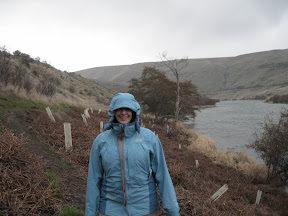 |
| From MattStansberry |
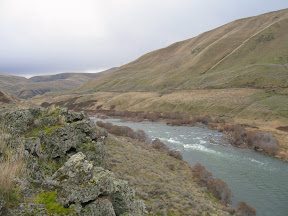 |
| From MattStansberry |
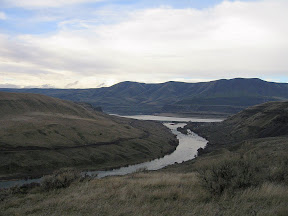 |
| From MattStansberry |
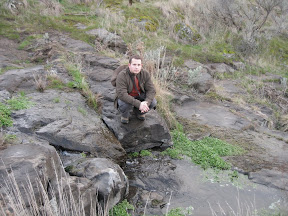 |
| From MattStansberry |
Saturday, February 24, 2007
Zumbo anti-assault rifle blog fuels gun nut hysteria
Zumbomania is causing a shitstorm. Former Outdoor Life columnist Jim Zumbo was unceremoniously canned this week for writing negatively about assault rifles in hunting situations.

I’m not a gun nut, but I own three that I hunt with -- 12 gage shotgun, .22 and a bolt action 7mm. I’m probably buying a handgun before I start doing much more predator calling in cougar country. And I tend to agree with Zumbo and Field & Stream’s David Petzl (more or less), that the AK-class rifle doesn’t have a place in the hunting community.
Sure, you should be able to have them, shoot them, store a bunch in the armory at your compound -- be ready for the rapture! But I don’t think they have a place in fair chase hunting.
I lived in Massachusetts for a year; I know excessive gun control is a problem. But the people arguing for my second amendment rights don’t speak for me.
Petzl has tried to address Zumbomania on his blog. And he has been smothered in negative comments. The people commenting on this post don’t understand. Petzl hit the nail on the head when said the lunatics are making themselves look like bigger morons. 741 comments so far, including this gem:
A man in good service to his country for 20 years that sells information to our enemy is still a TRAITOR. It doesn't matter who he is or what he has done. He betrayed us and is a TRAITOR.
This situation is no different. We are at WAR with the anti's. Every day, every night. If you think of it in any other fassion (sic), you have my pitty (sic).
We are many... and we are watching you.
Yeah... that's the kind of guy I want to see armed to the teeth.
Oddly enough, I was just getting ready to write a post about why Outdoor Life is a terrible publication and is bad for the outdoors community. Looks like that project just got a bit timelier. Funny thing: I had Zumbo listed as one of the magazine’s few redeeming qualities.
Update: I wrote this post last night, but was waiting to post it until today. Since that time, Zumbo's own Web site has been shut down either through too much traffic or malicious intent. This thing has gone crazy.
All this does is continue to separate gun nuts from sportsmen -- forking a larger group into two separate camps. And judging by the response, that's ok with me.

I’m not a gun nut, but I own three that I hunt with -- 12 gage shotgun, .22 and a bolt action 7mm. I’m probably buying a handgun before I start doing much more predator calling in cougar country. And I tend to agree with Zumbo and Field & Stream’s David Petzl (more or less), that the AK-class rifle doesn’t have a place in the hunting community.
Sure, you should be able to have them, shoot them, store a bunch in the armory at your compound -- be ready for the rapture! But I don’t think they have a place in fair chase hunting.
I lived in Massachusetts for a year; I know excessive gun control is a problem. But the people arguing for my second amendment rights don’t speak for me.
Petzl has tried to address Zumbomania on his blog. And he has been smothered in negative comments. The people commenting on this post don’t understand. Petzl hit the nail on the head when said the lunatics are making themselves look like bigger morons. 741 comments so far, including this gem:
A man in good service to his country for 20 years that sells information to our enemy is still a TRAITOR. It doesn't matter who he is or what he has done. He betrayed us and is a TRAITOR.
This situation is no different. We are at WAR with the anti's. Every day, every night. If you think of it in any other fassion (sic), you have my pitty (sic).
We are many... and we are watching you.
Yeah... that's the kind of guy I want to see armed to the teeth.
Oddly enough, I was just getting ready to write a post about why Outdoor Life is a terrible publication and is bad for the outdoors community. Looks like that project just got a bit timelier. Funny thing: I had Zumbo listed as one of the magazine’s few redeeming qualities.
Update: I wrote this post last night, but was waiting to post it until today. Since that time, Zumbo's own Web site has been shut down either through too much traffic or malicious intent. This thing has gone crazy.
All this does is continue to separate gun nuts from sportsmen -- forking a larger group into two separate camps. And judging by the response, that's ok with me.
Friday, February 23, 2007
Hunting philosophy evolves on hike
Hiking is good for my brain. It gives me a chance to get my head around ideas that otherwise I'd be too distracted to work out. KP and I were walking the Goodman Creek trail today and I noticed some bobcat tracks. The bobcat was following the trail for a long while and the tracks were really fresh. I think it was following the big flocks of thrushes that were picking gravel off of the trail.

The tracks were so fresh, they were still crumbling inward as we walked along. It had obviously backtracked our trail.
The bobcat got me thinking about predators, and hunting in general. I'm reading Robert Ruark's The Old Man and the Boy right now, and it's written in 1957 and set back a few decades before that. Ruark's boyhood character espouses a lot of interesting conservation ideas and is really ahead of his time in that sense, but one of the things I find interesting is how easy it is for him to go gather various game animals all around the house.
It reminds me of the way I want to hunt -- which is the way that I fish a lot of the time. Casually, taking what comes my way. But that's not really feasible at this point in our relationship with wild animals. The wild animals aren't there. I don't have the private land at my disposal to cultivate a good population of birds and small game to harvest.
Hunting has to be a committment at this point, not a past time like fishing is. I have to be willing to hunt on big game, which is managed intensively by state governments and biologists. I have to understand I might only shoot one bear in my life and it might take five years. Maybe I take a few elk, a deer every other year. And I have to spend a whole week, 4 days, tracking, packing it out on my back, making a committment to that animal and the few that are left.
There just aren't enough animals around to hunt casually anymore. Committment is coming -- bear season this spring.

The tracks were so fresh, they were still crumbling inward as we walked along. It had obviously backtracked our trail.
The bobcat got me thinking about predators, and hunting in general. I'm reading Robert Ruark's The Old Man and the Boy right now, and it's written in 1957 and set back a few decades before that. Ruark's boyhood character espouses a lot of interesting conservation ideas and is really ahead of his time in that sense, but one of the things I find interesting is how easy it is for him to go gather various game animals all around the house.
It reminds me of the way I want to hunt -- which is the way that I fish a lot of the time. Casually, taking what comes my way. But that's not really feasible at this point in our relationship with wild animals. The wild animals aren't there. I don't have the private land at my disposal to cultivate a good population of birds and small game to harvest.
Hunting has to be a committment at this point, not a past time like fishing is. I have to be willing to hunt on big game, which is managed intensively by state governments and biologists. I have to understand I might only shoot one bear in my life and it might take five years. Maybe I take a few elk, a deer every other year. And I have to spend a whole week, 4 days, tracking, packing it out on my back, making a committment to that animal and the few that are left.
There just aren't enough animals around to hunt casually anymore. Committment is coming -- bear season this spring.
Thursday, February 22, 2007
Oregon spring bear tag
I drew a tag for the Southwestern unit, Oregon spring bear hunt. Well, pretty much everybody that applied for one drew one. I guess not that many people want to hunt black bears in Oregon. I do.

I'll admit, I don't know the first thing about bear hunting. But I know I want to do it. A man has a right to chase his own bear -- whether or not I get one is a different story. I know I would use the hide, eat the meat, and the experience would change my life.
I bought a bunch of different brands of 7mm ammo, 175 grain. I'll be sighting in over the next few weeks.
Here is a line I love from the regulations: "Applying a scent or attractant to ones body or clothing while worn, is not baiting." If that's not a ballsy bear hunting strategy, I don't know what is. Just rub bacon all over yourself and wait.

I'll admit, I don't know the first thing about bear hunting. But I know I want to do it. A man has a right to chase his own bear -- whether or not I get one is a different story. I know I would use the hide, eat the meat, and the experience would change my life.
I bought a bunch of different brands of 7mm ammo, 175 grain. I'll be sighting in over the next few weeks.
Here is a line I love from the regulations: "Applying a scent or attractant to ones body or clothing while worn, is not baiting." If that's not a ballsy bear hunting strategy, I don't know what is. Just rub bacon all over yourself and wait.
Pheasant hunting at Fern Ridge
Here is the last of the articles I wrote for the now defunct Springfield News last fall.
Last chance for Fern Ridge pheasant this weekend
This is the last week of the Western Oregon Fee Pheasant Hunt Program at Fern Ridge, and hunters are getting a little frantic. I haven’t filled my tag, and neither have plenty of others.
Tuesday afternoon I met 21 year-old Josh Dunn of Eugene at the check station on the West Coyote Unit on Cantrell Road. Dunn was filling out his hunting permit at the same time I was and he invited me to join him and his two year-old German Shorthair, Doc.
I jumped on the invitation. I’d been walking Fern Ridge without a dog for weeks and was thrilled that I wouldn’t have to be the one diving into the burrs this time.
But a dog wouldn’t guarantee birds, according to Dunn. He said last season he probably shot 20 birds, but this year he hadn’t filled his first tag.
Hunters can buy as many tags for the Fee Pheasant Hunt program as they can fill. Each tag costs $11.50 and allows a hunter to take two rooster pheasants at Fern Ridge or other participating wildlife area, such as the E.E. Wilson Wildlife Area north of Corvallis.
Chinese Ring-Necked pheasant are an exotic species, first transplanted to Oregon’s Willamette Valley in 1881. The birds flourish in the dry cropland regions, but Western Oregon is too wet for them to sustain a population. So ODFW brings in farm-raised birds for hunters in the area.
The 2005-2006 hunt was a big success with dry conditions and an extended season that lasted to the end of October. A total of 1,444 birds were released and 1,074 birds were taken according to the Oregon Department of Fish and Wildlife (ODFW). Hunters had a success rate of just under 40% for the year.
Dunn has been hunting Fern Ridge regularly, coming in the mornings after getting off graveyard shift, and hunting some afternoons. He said he flushed some birds this season, but the corn and other crops had grown so high, it was hard to follow up with a decent shot.
It didn’t take long to understand exactly what he was experiencing. Dunn and I worked the perimeter of the West Coyote Unit for about an hour before we dove into the corn. The stalks towered over us, easily two feet over our heads.
About 20 yards into the row, a rooster flushed straight up in front of us and started over the field. Dunn scrambled to get into position for a shot, but the corn was too high, too thick. He took a shot anyway, but the bird was long gone.
We jumped another bird in the same stretch of corn ten minutes later, but the results were the same.
Wayne Morrow, Wildlife Biologist at Fern Ridge explained that no crops had been planted last year at all because water levels at Fern Ridge Lake had been drawn down to work on a dam project. This year the corn and millet are absolutely exploding, but Morrow pointed out that the cropland accounts for less than 10% of the hunting area.
Despite tougher conditions, Morrow said hunters are satisfied with the birds, which come from Mortenson’s Purple Sage game farm in Caldwell, Idaho.
“These birds aren’t that far out of the wild gene pool,” Morrow said. “They run if they can and fly if they have to. They’re big, beautiful birds.”
ODFW planted 70 pheasants across Fern Ridge on Wednesday night. It will plant 75 more this evening at 5:00 pm. The season runs through Sunday, October 8.
Pack your blaze orange and get there early, legal shooting starts at 6:51 am. I’ll see you out there -- I’ve still got a tag to fill.
Last chance for Fern Ridge pheasant this weekend
This is the last week of the Western Oregon Fee Pheasant Hunt Program at Fern Ridge, and hunters are getting a little frantic. I haven’t filled my tag, and neither have plenty of others.
Tuesday afternoon I met 21 year-old Josh Dunn of Eugene at the check station on the West Coyote Unit on Cantrell Road. Dunn was filling out his hunting permit at the same time I was and he invited me to join him and his two year-old German Shorthair, Doc.
I jumped on the invitation. I’d been walking Fern Ridge without a dog for weeks and was thrilled that I wouldn’t have to be the one diving into the burrs this time.
But a dog wouldn’t guarantee birds, according to Dunn. He said last season he probably shot 20 birds, but this year he hadn’t filled his first tag.
Hunters can buy as many tags for the Fee Pheasant Hunt program as they can fill. Each tag costs $11.50 and allows a hunter to take two rooster pheasants at Fern Ridge or other participating wildlife area, such as the E.E. Wilson Wildlife Area north of Corvallis.
Chinese Ring-Necked pheasant are an exotic species, first transplanted to Oregon’s Willamette Valley in 1881. The birds flourish in the dry cropland regions, but Western Oregon is too wet for them to sustain a population. So ODFW brings in farm-raised birds for hunters in the area.
The 2005-2006 hunt was a big success with dry conditions and an extended season that lasted to the end of October. A total of 1,444 birds were released and 1,074 birds were taken according to the Oregon Department of Fish and Wildlife (ODFW). Hunters had a success rate of just under 40% for the year.
Dunn has been hunting Fern Ridge regularly, coming in the mornings after getting off graveyard shift, and hunting some afternoons. He said he flushed some birds this season, but the corn and other crops had grown so high, it was hard to follow up with a decent shot.
It didn’t take long to understand exactly what he was experiencing. Dunn and I worked the perimeter of the West Coyote Unit for about an hour before we dove into the corn. The stalks towered over us, easily two feet over our heads.
About 20 yards into the row, a rooster flushed straight up in front of us and started over the field. Dunn scrambled to get into position for a shot, but the corn was too high, too thick. He took a shot anyway, but the bird was long gone.
We jumped another bird in the same stretch of corn ten minutes later, but the results were the same.
Wayne Morrow, Wildlife Biologist at Fern Ridge explained that no crops had been planted last year at all because water levels at Fern Ridge Lake had been drawn down to work on a dam project. This year the corn and millet are absolutely exploding, but Morrow pointed out that the cropland accounts for less than 10% of the hunting area.
Despite tougher conditions, Morrow said hunters are satisfied with the birds, which come from Mortenson’s Purple Sage game farm in Caldwell, Idaho.
“These birds aren’t that far out of the wild gene pool,” Morrow said. “They run if they can and fly if they have to. They’re big, beautiful birds.”
ODFW planted 70 pheasants across Fern Ridge on Wednesday night. It will plant 75 more this evening at 5:00 pm. The season runs through Sunday, October 8.
Pack your blaze orange and get there early, legal shooting starts at 6:51 am. I’ll see you out there -- I’ve still got a tag to fill.
Sid Evans, Editor in Chief of Field & Stream: Q&A
This is the second installment in a series of interviews that I'm pulling off of my old fishing site, FindFish101.com. I interviewed Sid Evans, editor in chief of Field & Stream a while back and this is an excerpt of that conversation.
Sid Evans, Editor in Chief of Field & Stream, may be the most influential person in fishing. Over 1.5 million readers rely on Evans and his staff to provide great stories about fishing from Minnesota to Mongolia.
Evans spoke to FindFish101.com from his Manhattan office to talk about what he's accomplished so far.

What are some of the biggest changes you've tried to push through since you started at F&S?
Evans: The magazine is 110 years old. It's the most recognized brand in the outdoors. It's got this incredible history. It's got an incredible amount of talent and always has. A lot of people in the fishing world grew up with [F&S writers] A.J. McClain and Ted Trueblood. When I got here three years ago, one thing I did not want to screw with was the history of the magazine, the quality of the writing, the quality of the how-to information -- the reliability of the content.
But we've also tried to bring a lot more humor into the book and a lot more energy. [F&S] has been the number one magazine in this category for such a long time that I think there was a perception that the magazine was a little bit tired. We've really tried to change that perception.
Fishing isn't tired. There are still millions of Americans out there who are absolutely obsessed with fishing and I want the pages of the magazine to reflect that.
I can just tell you, it's not the book I read in junior high.
Evans: We're trying to do some real journalism here, and not just in terms of covering important topics like conservation or what's happening in Washington. But we're also trying to find stories that are fresh and timely, stuff that's happening on the edge of fishing.
We ran a story in Dec/Jan. about fishing for Mako sharks with a fly rod. That's not brand new, but it hasn't been around that long and it's pretty exciting stuff. And I think people like to know what's going on out there.
Yeah. Fly fishing for sharks out of a kayak...
Evans: It's insane. It's insane, but there are guys out there doing it. I don't think the majority of our readers are going to go out and get a kayak and try to do that. They're smarter than that. But they like to read about it.
There are two types of articles F&S runs, fishing exotic locations versus fishing in your backyard. Which of those is more important to you?
Evans: Most guys want to know how to catch fish where they live. I think that's priority number one. I don't know the exact number of days our guys spend fishing, but if I had to guess I'd say it's over 50 days a year. So they're fishing all the time and they want to know how to catch more bass, trout, walleye; how to catch bigger ones. They're obsessed with the mystery of it, so they can't ever get enough information about how to catch the fish they're after in their area.
But the exotic stuff is fun to read. I think it's fun to tag along on those adventures. I think guys will save up, take maybe one trip per year to an exotic place, if that. But they like to read about it. I know I do, so I base it to some extent on that.
It seems like saltwater fishing has played a bigger role in the magazine lately. I'd seen an article that had suggested that the increased interest in saltwater fishing was due to stocks of stripers and redfish that have rebounded. Would you agree with that assessment?
Evans: I think saltwater fishing is an exploding sport. You look at what's happening on the Eastern Seaboard. The comeback of the striper has been just incredible and people have caught on to that. There are more and more guys out on the water. The redfish along the Gulf Coast have been unbelievable.
There are more fish out there to catch.
What kind of fishing did you do growing up?
Evans: I grew up in the south, fishing for crappie and bass around Memphis Tennessee with a bobber and a minnow. My family started taking family trips out West when I was twelve and that's where I discovered fly fishing and trout fishing -- fishing the Gallatin River in Montana, Yellowstone Park. That was a major discovery for me. Now I live in New York so I love to fish for stripers around the city and up in the Catskills, around the Delaware River.
I love trout fishing and I love the places where you can do it. But I've really flipped out over striper fishing in the last four or five years. It's gotten so good around New York. It's hard to beat catching a ten, twenty pound striper on a fly rod.
What are some of the best fishing articles from your magazine or others that stood out in 2005?
Evans: Chris Chivers' piece on fishing for alligator gar was great. I think the Kirk Deeter piece about fishing for Mako sharks was great as well. I think Sowbelly was a great book. It was about the pursuit of the record largemouth and all of the lunatics who are trying to catch that fish. It's a great book.
When it comes to politics and the outdoors, Field & Stream has to skate a fine line with that. How do you decide when it's too much?
Evans: It's inevitable. Politics do intersect with our sports, hunting and fishing, especially in the realm of conservation. We've been an advocate for conservation since day one of the magazine. Hunters and fishermen were, in a large part, responsible for most of the fish and game laws that were passed in this country.
We're running conservation pieces on a regular basis because it's a fight -- it's a battle to keep our resources. And not everybody is going to agree with you. When you run pieces that are advocating the protection of fish stocks, there's a situation where the commercial industry doesn't agree with everything the sport fishermen have to say.
It gets political and sometimes it rubs people the wrong way. But it's important to address these issues in the magazine and have those debates.
Sid Evans, Editor in Chief of Field & Stream, may be the most influential person in fishing. Over 1.5 million readers rely on Evans and his staff to provide great stories about fishing from Minnesota to Mongolia.
Evans spoke to FindFish101.com from his Manhattan office to talk about what he's accomplished so far.

What are some of the biggest changes you've tried to push through since you started at F&S?
Evans: The magazine is 110 years old. It's the most recognized brand in the outdoors. It's got this incredible history. It's got an incredible amount of talent and always has. A lot of people in the fishing world grew up with [F&S writers] A.J. McClain and Ted Trueblood. When I got here three years ago, one thing I did not want to screw with was the history of the magazine, the quality of the writing, the quality of the how-to information -- the reliability of the content.
But we've also tried to bring a lot more humor into the book and a lot more energy. [F&S] has been the number one magazine in this category for such a long time that I think there was a perception that the magazine was a little bit tired. We've really tried to change that perception.
Fishing isn't tired. There are still millions of Americans out there who are absolutely obsessed with fishing and I want the pages of the magazine to reflect that.
I can just tell you, it's not the book I read in junior high.
Evans: We're trying to do some real journalism here, and not just in terms of covering important topics like conservation or what's happening in Washington. But we're also trying to find stories that are fresh and timely, stuff that's happening on the edge of fishing.
We ran a story in Dec/Jan. about fishing for Mako sharks with a fly rod. That's not brand new, but it hasn't been around that long and it's pretty exciting stuff. And I think people like to know what's going on out there.
Yeah. Fly fishing for sharks out of a kayak...
Evans: It's insane. It's insane, but there are guys out there doing it. I don't think the majority of our readers are going to go out and get a kayak and try to do that. They're smarter than that. But they like to read about it.
There are two types of articles F&S runs, fishing exotic locations versus fishing in your backyard. Which of those is more important to you?
Evans: Most guys want to know how to catch fish where they live. I think that's priority number one. I don't know the exact number of days our guys spend fishing, but if I had to guess I'd say it's over 50 days a year. So they're fishing all the time and they want to know how to catch more bass, trout, walleye; how to catch bigger ones. They're obsessed with the mystery of it, so they can't ever get enough information about how to catch the fish they're after in their area.
But the exotic stuff is fun to read. I think it's fun to tag along on those adventures. I think guys will save up, take maybe one trip per year to an exotic place, if that. But they like to read about it. I know I do, so I base it to some extent on that.
It seems like saltwater fishing has played a bigger role in the magazine lately. I'd seen an article that had suggested that the increased interest in saltwater fishing was due to stocks of stripers and redfish that have rebounded. Would you agree with that assessment?
Evans: I think saltwater fishing is an exploding sport. You look at what's happening on the Eastern Seaboard. The comeback of the striper has been just incredible and people have caught on to that. There are more and more guys out on the water. The redfish along the Gulf Coast have been unbelievable.
There are more fish out there to catch.
What kind of fishing did you do growing up?
Evans: I grew up in the south, fishing for crappie and bass around Memphis Tennessee with a bobber and a minnow. My family started taking family trips out West when I was twelve and that's where I discovered fly fishing and trout fishing -- fishing the Gallatin River in Montana, Yellowstone Park. That was a major discovery for me. Now I live in New York so I love to fish for stripers around the city and up in the Catskills, around the Delaware River.
I love trout fishing and I love the places where you can do it. But I've really flipped out over striper fishing in the last four or five years. It's gotten so good around New York. It's hard to beat catching a ten, twenty pound striper on a fly rod.
What are some of the best fishing articles from your magazine or others that stood out in 2005?
Evans: Chris Chivers' piece on fishing for alligator gar was great. I think the Kirk Deeter piece about fishing for Mako sharks was great as well. I think Sowbelly was a great book. It was about the pursuit of the record largemouth and all of the lunatics who are trying to catch that fish. It's a great book.
When it comes to politics and the outdoors, Field & Stream has to skate a fine line with that. How do you decide when it's too much?
Evans: It's inevitable. Politics do intersect with our sports, hunting and fishing, especially in the realm of conservation. We've been an advocate for conservation since day one of the magazine. Hunters and fishermen were, in a large part, responsible for most of the fish and game laws that were passed in this country.
We're running conservation pieces on a regular basis because it's a fight -- it's a battle to keep our resources. And not everybody is going to agree with you. When you run pieces that are advocating the protection of fish stocks, there's a situation where the commercial industry doesn't agree with everything the sport fishermen have to say.
It gets political and sometimes it rubs people the wrong way. But it's important to address these issues in the magazine and have those debates.
Wednesday, February 21, 2007
Fast water, slow fishing this week
I spent a little time on a coastal trib Sunday afternoon, finally saw a nice steelhead on a river I've been scheming on. Didn't catch him though. Winter steelhead 5 -- Matt 0. I did hook a couple cutthroats though while I was there.
Tomorrow morning I am headed out to scout Bull Trout fry in the Upper Willamette Basin with some folks from the Forest Service and ODFW. I'll let everyone know how that works out.
Update: Biologists bailed out today due to crappy weather in Oakridge. We're rescheduled for March 20th.
Tomorrow morning I am headed out to scout Bull Trout fry in the Upper Willamette Basin with some folks from the Forest Service and ODFW. I'll let everyone know how that works out.
Update: Biologists bailed out today due to crappy weather in Oakridge. We're rescheduled for March 20th.
Tuesday, February 20, 2007
Oregon Cascades Hot Springs
Last weekend KP and I did a mini-tour of the Oregon Cascades hot springs.
Our hot springs experience started at Belknap Hot Springs, a secluded resort tucked in off of Rte 126. The folks at Belknap charge $10.50 for day use of the springs, guests soak for free. It’s a nice big pool, super clear and nicely heated water (102 degrees). The main pool is located right on the McKenzie and the hot spring bubbles up from the other side of the river. According to Belknap’s Web site, the water comes out of the ground at 200 degrees, full of minerals (mostly sodium, chloride and sulfate). The pool is five feet at its deepest point and not overly crowded, even on weekend mornings or evenings. But, it gets a little boring after a while.
On the other hand, nearby Terwilliger Hot Springs is anything but boring. KP and I drove down there to check it out, just about an hour before dark on Saturday. The parking lot was packed, but the fee collector ($5) had closed up shop for the day, so we got to check it out for free.
There was ample warning that this was a clothing-optional kind of place and KP and I were debating whether to go nude or not. But after hiking back a quarter mile and seeing what we were getting into, we opted to put on the bathing suits.
It was probably the oddest grouping of people I’d ever seen. I’d say it was half young couples and the other half was older hippie guys. Plus, throw in a couple meth-head looking dudes in dirty clothes that looked like they never showered, and the Wolfman.
The Wolfman could have been anywhere between 30 and 60 years old, with a mane of hair and a beard down to his nipples. He spent about half of the time in the hot spring, the other half he spent perched on the cliff above, kind of sitting like a wolf.
To be honest, I found it to be a little too much. Naked attractive women, guys who looked like they would steal everything I own, and a Wolfman. It wasn’t exactly relaxing.
Plus, the water itself made me wonder why we ever left Belknap. I’m all for “natural” experiences and hot springs connoisseurs will make fun of me -- but this was madness. The water couldn’t have been more than 80 degrees. And its consistency was like egg drop soup, with belly button lint floating in it. You can’t tell me something wasn’t living in that muck.
Healing mineral bath anyone? More like hepatitis. But, free is free, so we sat in it for a while, eating oranges with the hippie dudes, trying to figure out how we knew this naked girl sitting next to us.
Well, there you have the two extremes of Oregon Cascades hot springs: Pricey and pretty vs. cheap and gritty.
I do have a few more words on the lodging situation at Belknap Springs. Rooms range at around $100 per night, and if you were smart you’d get a cabin instead. The cabins are more private than the lodge rooms and are half the price. Lodge room beds are pretty lame, the room temperatures are impossible to control and the walls are paper thin. The only thing with the rustic cabins is that you need to bring your own bedding, pillows and towels.
Our hot springs experience started at Belknap Hot Springs, a secluded resort tucked in off of Rte 126. The folks at Belknap charge $10.50 for day use of the springs, guests soak for free. It’s a nice big pool, super clear and nicely heated water (102 degrees). The main pool is located right on the McKenzie and the hot spring bubbles up from the other side of the river. According to Belknap’s Web site, the water comes out of the ground at 200 degrees, full of minerals (mostly sodium, chloride and sulfate). The pool is five feet at its deepest point and not overly crowded, even on weekend mornings or evenings. But, it gets a little boring after a while.
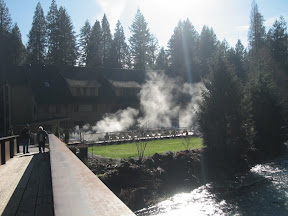 |
| From MattStansberry |
On the other hand, nearby Terwilliger Hot Springs is anything but boring. KP and I drove down there to check it out, just about an hour before dark on Saturday. The parking lot was packed, but the fee collector ($5) had closed up shop for the day, so we got to check it out for free.
There was ample warning that this was a clothing-optional kind of place and KP and I were debating whether to go nude or not. But after hiking back a quarter mile and seeing what we were getting into, we opted to put on the bathing suits.
It was probably the oddest grouping of people I’d ever seen. I’d say it was half young couples and the other half was older hippie guys. Plus, throw in a couple meth-head looking dudes in dirty clothes that looked like they never showered, and the Wolfman.
The Wolfman could have been anywhere between 30 and 60 years old, with a mane of hair and a beard down to his nipples. He spent about half of the time in the hot spring, the other half he spent perched on the cliff above, kind of sitting like a wolf.
To be honest, I found it to be a little too much. Naked attractive women, guys who looked like they would steal everything I own, and a Wolfman. It wasn’t exactly relaxing.
Plus, the water itself made me wonder why we ever left Belknap. I’m all for “natural” experiences and hot springs connoisseurs will make fun of me -- but this was madness. The water couldn’t have been more than 80 degrees. And its consistency was like egg drop soup, with belly button lint floating in it. You can’t tell me something wasn’t living in that muck.
Healing mineral bath anyone? More like hepatitis. But, free is free, so we sat in it for a while, eating oranges with the hippie dudes, trying to figure out how we knew this naked girl sitting next to us.
Well, there you have the two extremes of Oregon Cascades hot springs: Pricey and pretty vs. cheap and gritty.
I do have a few more words on the lodging situation at Belknap Springs. Rooms range at around $100 per night, and if you were smart you’d get a cabin instead. The cabins are more private than the lodge rooms and are half the price. Lodge room beds are pretty lame, the room temperatures are impossible to control and the walls are paper thin. The only thing with the rustic cabins is that you need to bring your own bedding, pillows and towels.
Oregon Feature Photo: Oregon fishing
Christopher, aka honjooshi58 took this photo on a beach south of Tillamook. "I saw a guy fishing. Thought it would make a good picture, took the shot," he said. The light is just amazing.
Monday, February 19, 2007
Snowshoeing in the Cascade Mountains
KP and I set off on Friday for a long weekend of snowshoeing in the Cascade Mountains. Neither of us had ever been snowshoeing before and we didn’t know what to expect. I assumed that the Cascades were impassable through the winter. It’s the main thing that’s been scaring me out of trying to fish eastern Oregon the past month or so. Turns out, I was way off.
Highway 126 didn’t have a drop of snow on it from Eugene to Sisters. The state keeps it pretty well maintained. You can run into issues when there are storms, and that’s why you carry chains in the car, but for the most part it’s pretty simple.
Earlier that day I’d gone through chaining up the practice tire in the Les Schwab showroom three times, concentrating as if my life would depend on it, literally, in the next couple hours.
After getting the chain lessons I picked up our Atlas snowshoes from a surly gear manager at REI, Eugene, who didn’t offer a bit of advice or even instruction on the things I was asking about:
Is this a good map of the area?
REI guy: I don’t think the area you’re going to is on there…
It was on there.
What about this snowshoeing book, is it any good?
REI guy: We sell out of it all the time.
It was pretty crappy and confusing.
Any advice on putting these things on?
REI guy: They’re pretty simple
I had them on the wrong feet for at least half of the trip. And I’m still not sure which feet go where.
When we started driving up the Cascades, the sky had opened up and the entire western side of the range was socked in with rain. We checked into our hotel and decided to keep heading east, rather than wait out the rain, and worst case we’d just go to a bar, fly shop, bookstore or something in Sisters, OR.
Just as we were crossing the pass, up around the Metolius River, the sky broke and it was a blue bird day in Sisters. We stopped in at the local fly shop (where I always go for advice, even if it's not about fishing) and the guy sent us out to Three Lake Creek, a Snowpark just south of town.
We parked in the Snowpark where some RVs and snowmobiles were set up and started hiking at the snow gate. I didn’t look at the sign on the gate or read the snowshoeing book carefully. If I would have, I’d have known we were attempting a 13 mile roundtrip route with a 1000 foot elevation gain, 90 minutes before dark.
We were a little too scared to get off the rutted snowmobile trails. Broken snowmobile parts littered the snow and you could hear them revving in the background. Also, three jets flew overhead while we were walking, taking away the idea of the snowy wilderness. We must have been on some sort of eastbound flyway. We were not seeing the full beauty of the snowshoe enthusiast’s isolation.
Obviously we didn’t reach the top of the hike, but I kept thinking a viewpoint was around the next corner so we kept pushing. Eventually I tried to do a shortcut to see over the ridge, but all I could see was more trees so we turned back, craving Mexican food in Sisters.
Download an Oregon Outdoor Journal Wilderness-cast MP3 on the Three Creek Lake snowshoeing debacle.
 |
| From MattStansberry |
Highway 126 didn’t have a drop of snow on it from Eugene to Sisters. The state keeps it pretty well maintained. You can run into issues when there are storms, and that’s why you carry chains in the car, but for the most part it’s pretty simple.
Earlier that day I’d gone through chaining up the practice tire in the Les Schwab showroom three times, concentrating as if my life would depend on it, literally, in the next couple hours.
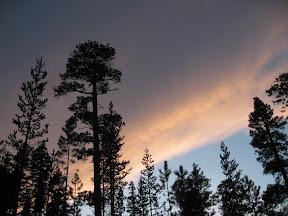 |
| From MattStansberry |
After getting the chain lessons I picked up our Atlas snowshoes from a surly gear manager at REI, Eugene, who didn’t offer a bit of advice or even instruction on the things I was asking about:
Is this a good map of the area?
REI guy: I don’t think the area you’re going to is on there…
It was on there.
What about this snowshoeing book, is it any good?
REI guy: We sell out of it all the time.
It was pretty crappy and confusing.
Any advice on putting these things on?
REI guy: They’re pretty simple
I had them on the wrong feet for at least half of the trip. And I’m still not sure which feet go where.
When we started driving up the Cascades, the sky had opened up and the entire western side of the range was socked in with rain. We checked into our hotel and decided to keep heading east, rather than wait out the rain, and worst case we’d just go to a bar, fly shop, bookstore or something in Sisters, OR.
Just as we were crossing the pass, up around the Metolius River, the sky broke and it was a blue bird day in Sisters. We stopped in at the local fly shop (where I always go for advice, even if it's not about fishing) and the guy sent us out to Three Lake Creek, a Snowpark just south of town.
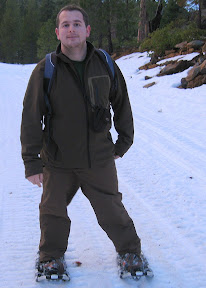 |
| From MattStansberry |
We parked in the Snowpark where some RVs and snowmobiles were set up and started hiking at the snow gate. I didn’t look at the sign on the gate or read the snowshoeing book carefully. If I would have, I’d have known we were attempting a 13 mile roundtrip route with a 1000 foot elevation gain, 90 minutes before dark.
We were a little too scared to get off the rutted snowmobile trails. Broken snowmobile parts littered the snow and you could hear them revving in the background. Also, three jets flew overhead while we were walking, taking away the idea of the snowy wilderness. We must have been on some sort of eastbound flyway. We were not seeing the full beauty of the snowshoe enthusiast’s isolation.
Obviously we didn’t reach the top of the hike, but I kept thinking a viewpoint was around the next corner so we kept pushing. Eventually I tried to do a shortcut to see over the ridge, but all I could see was more trees so we turned back, craving Mexican food in Sisters.
Download an Oregon Outdoor Journal Wilderness-cast MP3 on the Three Creek Lake snowshoeing debacle.
Crushed under the weight of technology
It's been a few days, hiding out up in the Cascades over the weekend for Valentines Day w/ KP. I've been meaning to blog, but...
Despite holing up in a mountain resort all weekend, I have been busy working on stuff for the Oregon Outdoor Journal.
I'll take this time to do a mini review: First of all, I've nursed my Canon PowerShot back to life and I'm eager to see if I can get decent picture quality out of the formerly soggy camera -- look for some footage later tonight or tomorrow. I've literally dunked this thing 3 or 4 times and it keeps coming back. And I love the pictures it takes. I hope this batch of photos looks ok. They seem ok on the display screen, but there might be some fog on the images. We'll see when I blow them up full size.
Secondly, I've been carrying my Olympus digital voice recorder with me for the last few trips because it's easier to use than writing notes while I'm hiking or fishing. Turns out, some of the recordings are pretty funny, like listening to me huffing up a hill in snowshoes, trying to act all cool about how beautiful it is up there. So I'm planning on setting up an audio component to OOJ.
I've managed to get my laptop to recognize the device, now if I can figure out how to use the free auido software Audacity I'll be in great shape.
Despite holing up in a mountain resort all weekend, I have been busy working on stuff for the Oregon Outdoor Journal.
I'll take this time to do a mini review: First of all, I've nursed my Canon PowerShot back to life and I'm eager to see if I can get decent picture quality out of the formerly soggy camera -- look for some footage later tonight or tomorrow. I've literally dunked this thing 3 or 4 times and it keeps coming back. And I love the pictures it takes. I hope this batch of photos looks ok. They seem ok on the display screen, but there might be some fog on the images. We'll see when I blow them up full size.
Secondly, I've been carrying my Olympus digital voice recorder with me for the last few trips because it's easier to use than writing notes while I'm hiking or fishing. Turns out, some of the recordings are pretty funny, like listening to me huffing up a hill in snowshoes, trying to act all cool about how beautiful it is up there. So I'm planning on setting up an audio component to OOJ.
I've managed to get my laptop to recognize the device, now if I can figure out how to use the free auido software Audacity I'll be in great shape.
Thursday, February 15, 2007
Backpacker Gear Guide 2007
After reading the annual Backpacker Gear Guide 2007, I came up with a wish-list of stuff I want. I already had boots and a backpack that I was pretty happy with, so those categories weren’t very interesting. KP and I decided (ok, I decided) to get a “Sew your own” Ray Jardine quilt kit instead of a sleeping bag, so that category is out too.

I was interested in tents, since my Eureka Apex doesn’t vent and is really bulky. I see the Marmot Aeolos 2P won best all-around. But it’s $325 and weighs more than the tent I’ve already got. Then up on the top of the page there is a “Reader Approved” Eureka Pinnacle Pass 2XTA -- which looks more ventilated than my current tent, it’s a pound lighter, and it’s only $150. But at the same time it’s another low-end Eureka tent.

While this is a quandary, the good news is that I’ve been researching tarp camping more, and that might be the way to go in summer. Or make the most of my old tent, opening the doors and draping a mesh over the top. Luckily Backpacker gave me a tip for packing my bulky old tent: Stuff the tent, rainfly, polls and stakes into different stuff sacs.
Other stuff I’m interested in: Outdoor Research ExPed MultiMat.


I was interested in tents, since my Eureka Apex doesn’t vent and is really bulky. I see the Marmot Aeolos 2P won best all-around. But it’s $325 and weighs more than the tent I’ve already got. Then up on the top of the page there is a “Reader Approved” Eureka Pinnacle Pass 2XTA -- which looks more ventilated than my current tent, it’s a pound lighter, and it’s only $150. But at the same time it’s another low-end Eureka tent.

While this is a quandary, the good news is that I’ve been researching tarp camping more, and that might be the way to go in summer. Or make the most of my old tent, opening the doors and draping a mesh over the top. Luckily Backpacker gave me a tip for packing my bulky old tent: Stuff the tent, rainfly, polls and stakes into different stuff sacs.
Other stuff I’m interested in: Outdoor Research ExPed MultiMat.

Wednesday, February 14, 2007
Poacher scum steal fish from Whittaker Creek traps
This just in: Poachers steal fish out of the ODFW traps at Whittaker Creek, a tributary of the Siuslaw. See below:
According to KEZI-9, thieves stole about 150 spawning steelhead sometime Monday night.
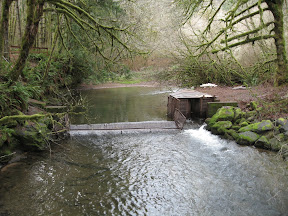 |
| From MattStansberry |
According to KEZI-9, thieves stole about 150 spawning steelhead sometime Monday night.
Oregon feature photo: Clammers
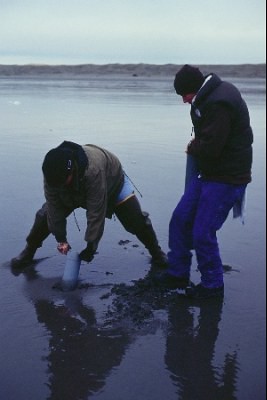
Today's Oregon feature photo comes from Chelsia A. Rice, who said: The photo was taken just South of Warrenton on the Oregon coast. Pictured is Gina Ensuna and Sharla Crawford (L to R). Photo was taken with 100 Kodak color slide film. We didn't catch any clams that day. They were too fast for us. Looks like we'll have to make another trip. This photo was taken on Dec. 29th, 2006.
Chelsia also pointed out that her uncle is part owner for a little hotel in Minam, Oregon that has gotten some press in the Register-Guard recently. The outfit offers fishing and rafting trips down the Wallowa river year round and a train to take you back the hotel.
CJ Chivers on outdoors writing
CJ Chivers interview: Here is the first of a couple interviews and recipes I'm salvaging from FindFish101.com. For those of you just tuning in, check here for the background.
This is an interview I did in late 2005 if I remember correctly. It was a Saturday morning and I was calling Chivers in Russia to talk about fishing, writing, beer and perserverence. It was incredibly generous of him to give me an inteview and he opened some doors for me down the road -- the conversation stands out as one of the formative experiences in my adult life.
CJ Chivers on fishing and journalism
Recreational angler CJ Chivers, a 40-year old Moscow correspondent for the NY Times, is shaping the way America thinks about fishing.
Chivers honed his fishing skills on the Susquehanna River and Cayuga Lake in upstate New York growing up. Following a stint as a U.S. Marine Corps infantry officer, Chivers went on to write for the Providence Journal and then the Times, where he covered the 9/11 collapse from the front lines.
Lately, when he's not running ragged through the former Soviet Union, Chivers has been publishing fishing articles in some of the most influential magazines in the country.
The first time I read a Chivers fishing piece was the November, 2004 issue of Esquire, "Cult of the Striper". Then I saw his byline again on one of the most interesting fishing stories I'd ever read -- Fishing For Dinosaurs, an article about land-based fishing for giant alligator gar, in Field & Stream.
In an industry often overshadowed by glamour travel, boat fishing and gear, Chivers offers the simple voice of a fisherman connecting with his quarry. He gave FindFish101.com some insight into his fishing experiences during a recent phone interview from Moscow.

Can you tell me about the changes you've seen in outdoors writing in the past few years?
Most of what you'd call the outdoor writing circuit had gone in the wrong direction over the last twenty years. The writing was not that fresh. There were exceptions, but I think a lot of the readership got turned off to the perpetual sameness and transparent shilling that was going on with some of the magazines, and still goes on with some of them.
There had been some upstart magazines, like On The Water out of New England, which is a terrifically fresh and insightful magazine. It just crackles with local knowledge and enthusiasm.
When Sid Evans [editor] came over to Field & Stream, he wanted to bring back some of the Field & Stream legacy. I think he understood some of the ailments that afflicted the industry and he's been trying to undo it on his property. He did a redesign, tried to bring in new writers, fresher layouts. He's really looking to elevate the magazine back to its old stature with an updated look. And it's been really fun to be a part of it.
And they're now doing the same thing at Saltwater Sportsman, another magazine with an incredible legacy that ran aground.
That's something I'd noticed. Are saltwater magazines starting to take another look at surf fishing? The money has to be in advertising for boats.
If you go back and look at the history of Saltwater Sportsman, when Frank Woolner and his fishing buddies were putting this thing out... If you can get your hands on an old copy at a garage sale from the 1960s and 1970s... what a magazine. It really spoke to fishing in all of its aspects and was written by people who were fishing all the time. They loved their sport and knew a lot about it and were trying to tell the readers all about it.
I didn't read it regularly through the 1980s, so I don't know exactly where the turn came. But by the time I really took a close look at it again in the late 1990s, it had become a "how to catch fish out of boats" magazine. It was almost unreadable.
Fishing on foot is back in at the magazine. They still do a lot of fishing on the boats and they cover both offshore and inshore. But they cover fishing in all of its aspects again.
You cover the conservation issues, as well as tactics and point of view pieces. What do you like writing best?
I don't write a lot of how-to articles. I've written a few. There are people out there who do a better job than me at how-to articles, and there are a lot of better fishermen than me at certain techniques.
If I'm on to something that I think is a little different or unusual that I don't see other people doing, I'll lay out an article. Sometimes they're really offbeat. A few years ago I wrote a short piece on how to catch hickory shad on light tackle. I just wrote a piece in Saltwater Sportsman that they'll probably run next year on how to catch false albacore off the beach using steelhead tackle to throw really light jigs at these fish. There are very few people doing it, and if you become one of them you'll have some success and stop being skunked on these fish.
I prefer writing conservation articles because it's not as covered and I enjoy writing essays on fishing, which is something else altogether.
You wrote an article on catching giant alligator gar in Texas that I really liked. Would you consider those fish dangerous quarry?
Fishing is dangerous to me in the sense that you can have a bad accident on your boat or bust your head open jumping around on wet rocks at night. But I don't think the quarry itself is dangerous.
Maybe a bluefish is dangerous. You might need a few stitches if you're not careful around the hot end. But to me, it's the conditions that can get you more than the fish.
It just seems like predator species have a certain glamour attached to them.
Yeah, but we're the predators. Let's be serious. How many people do you know that have been killed by a fish? It's a boating accident in a storm or drowning by any number of means... taking the wrong step in a walleye river, flipping a canoe in a cold pond. That's where we die. We don't die at the hands of fish.
I didn't think the gar were dangerous. You just needed to be careful handling them. That's all. I'm careful around my neighbor's dog.
You cover such serious topics in your day job. How do you contrast such serious journalism with your fishing writing?
I take fishing very seriously. I don't remember not fishing. My dad taught me to fish really young. I went fishing through the ice, just beyond being a toddler, with my dad. I approach it with the same seriousness of my day job.
I try to research the topic. I try to connect to the people that I spend time with. I try to ask myself why I'm there and what it means that I'm there. Sometimes a fishing story isn't going to have the same self-evident energy that covering the 9/11 collapses would. Of course not. And for that reason, some of the [fishing] stories aren't as resonant as the stuff I do in the New York Times to the general reader. But to me, they are every bit personally as important as some of the stories I've done on the job.
Fishing makes me happy. So fishing writing is a way I can combine my day job - which can be extraordinarily emotionally and physically draining -- fishing writing is a way to combine it with something I love to do. It's a way to restore some joy to the keyboard.
In most of my fishing stories for instance, I can do a story where nobody dies and nothing gets stolen. We cover a lot of grim stuff out here.
Speaking of your current location, do you get to do any fishing in Russia? I understand there are some really great fisheries on that East Coast.
I'm planning to go. I'm planning two really exciting fishing trips for next year, not counting the ice fishing. I'm going to try to do some ice fishing this winter. I grew up ice fishing and I love the sport.
I had big plans to go fishing last year, but the past fifteen months in Russia turned out to be crazy. From [the school massacre] in Beslan to the Ukrainian Revolution, to the Kyrgyz revolution, the massacre in Andijon in Uzbekistan... we never had time to get out of position. You risk traveling eight time zones to get to good fishing water and your beat blows up back here in the western part of the former Soviet Union, and then you're dead. You're at the wrong end of the field.
If next year is quieter I have two really exciting fishing trips planned. One is up in the Tajikistan Mountains along the Chinese and Afghan border, fishing for snow trout. The other is in the Russian far east in Kamchatka. fishing the salmon rivers. Knock on wood, I'll actually get to do these trips.
What's your favorite type of fishing?
For me, it's striped bass fishing at night in the surf on Block Island or on the Rhode Island shore. Because you're out there all alone, there's a good number of fish and it's a huge technical challenge to reach them and also get them in, balancing tackle fine enough to make a good presentation, but strong enough to handle them.
Night fishing seems like the biggest pain in the ass. I've been out there.
No, no. It's the most fun of all. Everything drops away. There's no distraction. You're all alone, the crowded beach is empty. The fish are running twenty times as thick as they run in the day. The fish are large, tasty. And when you're out there at night it completely centers you on what you're doing.
It's very hard to be very good at a lot of things in life. You've got your job, and it's going to be something you want to figure out. That consumes your days. You can get good at being with your family, and that consumes your spare time. What does that leave you for fishing? Well, take up night fishing then. If you're willing to throw your sleep away, you can get really good at night fishing. And if you're going after striped bass and bluefish, you can catch a hell of a lot of fish.
It's really possible to hold down a job and become a very savvy night fisherman if you put in a couple hundred nights. If you've got a demanding day job, you're never going to be a good offshore fisherman. How are you going to get out there? But if you're lucky enough to live within an hour, hour and a half of a fishing spot, you can be down on the water, fish a few hours, get back and get four or five hours sleep and go back to work. You can catch a hell of a lot of fish and figure this thing out.
This is an interview I did in late 2005 if I remember correctly. It was a Saturday morning and I was calling Chivers in Russia to talk about fishing, writing, beer and perserverence. It was incredibly generous of him to give me an inteview and he opened some doors for me down the road -- the conversation stands out as one of the formative experiences in my adult life.
CJ Chivers on fishing and journalism
Recreational angler CJ Chivers, a 40-year old Moscow correspondent for the NY Times, is shaping the way America thinks about fishing.
Chivers honed his fishing skills on the Susquehanna River and Cayuga Lake in upstate New York growing up. Following a stint as a U.S. Marine Corps infantry officer, Chivers went on to write for the Providence Journal and then the Times, where he covered the 9/11 collapse from the front lines.
Lately, when he's not running ragged through the former Soviet Union, Chivers has been publishing fishing articles in some of the most influential magazines in the country.
The first time I read a Chivers fishing piece was the November, 2004 issue of Esquire, "Cult of the Striper". Then I saw his byline again on one of the most interesting fishing stories I'd ever read -- Fishing For Dinosaurs, an article about land-based fishing for giant alligator gar, in Field & Stream.
In an industry often overshadowed by glamour travel, boat fishing and gear, Chivers offers the simple voice of a fisherman connecting with his quarry. He gave FindFish101.com some insight into his fishing experiences during a recent phone interview from Moscow.

Can you tell me about the changes you've seen in outdoors writing in the past few years?
Most of what you'd call the outdoor writing circuit had gone in the wrong direction over the last twenty years. The writing was not that fresh. There were exceptions, but I think a lot of the readership got turned off to the perpetual sameness and transparent shilling that was going on with some of the magazines, and still goes on with some of them.
There had been some upstart magazines, like On The Water out of New England, which is a terrifically fresh and insightful magazine. It just crackles with local knowledge and enthusiasm.
When Sid Evans [editor] came over to Field & Stream, he wanted to bring back some of the Field & Stream legacy. I think he understood some of the ailments that afflicted the industry and he's been trying to undo it on his property. He did a redesign, tried to bring in new writers, fresher layouts. He's really looking to elevate the magazine back to its old stature with an updated look. And it's been really fun to be a part of it.
And they're now doing the same thing at Saltwater Sportsman, another magazine with an incredible legacy that ran aground.
That's something I'd noticed. Are saltwater magazines starting to take another look at surf fishing? The money has to be in advertising for boats.
If you go back and look at the history of Saltwater Sportsman, when Frank Woolner and his fishing buddies were putting this thing out... If you can get your hands on an old copy at a garage sale from the 1960s and 1970s... what a magazine. It really spoke to fishing in all of its aspects and was written by people who were fishing all the time. They loved their sport and knew a lot about it and were trying to tell the readers all about it.
I didn't read it regularly through the 1980s, so I don't know exactly where the turn came. But by the time I really took a close look at it again in the late 1990s, it had become a "how to catch fish out of boats" magazine. It was almost unreadable.
Fishing on foot is back in at the magazine. They still do a lot of fishing on the boats and they cover both offshore and inshore. But they cover fishing in all of its aspects again.
You cover the conservation issues, as well as tactics and point of view pieces. What do you like writing best?
I don't write a lot of how-to articles. I've written a few. There are people out there who do a better job than me at how-to articles, and there are a lot of better fishermen than me at certain techniques.
If I'm on to something that I think is a little different or unusual that I don't see other people doing, I'll lay out an article. Sometimes they're really offbeat. A few years ago I wrote a short piece on how to catch hickory shad on light tackle. I just wrote a piece in Saltwater Sportsman that they'll probably run next year on how to catch false albacore off the beach using steelhead tackle to throw really light jigs at these fish. There are very few people doing it, and if you become one of them you'll have some success and stop being skunked on these fish.
I prefer writing conservation articles because it's not as covered and I enjoy writing essays on fishing, which is something else altogether.
You wrote an article on catching giant alligator gar in Texas that I really liked. Would you consider those fish dangerous quarry?
Fishing is dangerous to me in the sense that you can have a bad accident on your boat or bust your head open jumping around on wet rocks at night. But I don't think the quarry itself is dangerous.
Maybe a bluefish is dangerous. You might need a few stitches if you're not careful around the hot end. But to me, it's the conditions that can get you more than the fish.
It just seems like predator species have a certain glamour attached to them.
Yeah, but we're the predators. Let's be serious. How many people do you know that have been killed by a fish? It's a boating accident in a storm or drowning by any number of means... taking the wrong step in a walleye river, flipping a canoe in a cold pond. That's where we die. We don't die at the hands of fish.
I didn't think the gar were dangerous. You just needed to be careful handling them. That's all. I'm careful around my neighbor's dog.
You cover such serious topics in your day job. How do you contrast such serious journalism with your fishing writing?
I take fishing very seriously. I don't remember not fishing. My dad taught me to fish really young. I went fishing through the ice, just beyond being a toddler, with my dad. I approach it with the same seriousness of my day job.
I try to research the topic. I try to connect to the people that I spend time with. I try to ask myself why I'm there and what it means that I'm there. Sometimes a fishing story isn't going to have the same self-evident energy that covering the 9/11 collapses would. Of course not. And for that reason, some of the [fishing] stories aren't as resonant as the stuff I do in the New York Times to the general reader. But to me, they are every bit personally as important as some of the stories I've done on the job.
Fishing makes me happy. So fishing writing is a way I can combine my day job - which can be extraordinarily emotionally and physically draining -- fishing writing is a way to combine it with something I love to do. It's a way to restore some joy to the keyboard.
In most of my fishing stories for instance, I can do a story where nobody dies and nothing gets stolen. We cover a lot of grim stuff out here.
Speaking of your current location, do you get to do any fishing in Russia? I understand there are some really great fisheries on that East Coast.
I'm planning to go. I'm planning two really exciting fishing trips for next year, not counting the ice fishing. I'm going to try to do some ice fishing this winter. I grew up ice fishing and I love the sport.
I had big plans to go fishing last year, but the past fifteen months in Russia turned out to be crazy. From [the school massacre] in Beslan to the Ukrainian Revolution, to the Kyrgyz revolution, the massacre in Andijon in Uzbekistan... we never had time to get out of position. You risk traveling eight time zones to get to good fishing water and your beat blows up back here in the western part of the former Soviet Union, and then you're dead. You're at the wrong end of the field.
If next year is quieter I have two really exciting fishing trips planned. One is up in the Tajikistan Mountains along the Chinese and Afghan border, fishing for snow trout. The other is in the Russian far east in Kamchatka. fishing the salmon rivers. Knock on wood, I'll actually get to do these trips.
What's your favorite type of fishing?
For me, it's striped bass fishing at night in the surf on Block Island or on the Rhode Island shore. Because you're out there all alone, there's a good number of fish and it's a huge technical challenge to reach them and also get them in, balancing tackle fine enough to make a good presentation, but strong enough to handle them.
Night fishing seems like the biggest pain in the ass. I've been out there.
No, no. It's the most fun of all. Everything drops away. There's no distraction. You're all alone, the crowded beach is empty. The fish are running twenty times as thick as they run in the day. The fish are large, tasty. And when you're out there at night it completely centers you on what you're doing.
It's very hard to be very good at a lot of things in life. You've got your job, and it's going to be something you want to figure out. That consumes your days. You can get good at being with your family, and that consumes your spare time. What does that leave you for fishing? Well, take up night fishing then. If you're willing to throw your sleep away, you can get really good at night fishing. And if you're going after striped bass and bluefish, you can catch a hell of a lot of fish.
It's really possible to hold down a job and become a very savvy night fisherman if you put in a couple hundred nights. If you've got a demanding day job, you're never going to be a good offshore fisherman. How are you going to get out there? But if you're lucky enough to live within an hour, hour and a half of a fishing spot, you can be down on the water, fish a few hours, get back and get four or five hours sleep and go back to work. You can catch a hell of a lot of fish and figure this thing out.
Monday, February 12, 2007
Where fishing web sites go to die
Waaaay back in 2005, one of my good buddies and I decided we were going to get rich spinning fish tales. I was an aspiring outdoors writer, just breaking into some of the regional fishing magazines on the east coast. My partner Tanklin, well, he was a man of many trades, see below:

A few words about Tank: He wasn’t a Web designer, nor a writer by trade. He wasn’t even an angler, really. But he liked to eat fish and that was good enough. Tank went out and built a beautiful online fishing magazine out of Blogger tools, Photoshop and my hubris.
See, I had a vision. Think: New Yorker meets In-Fisherman. I wanted an online, literary fishing magazine full of great photos. Simple design. No crappy moving ads, no five different fonts on the page, no extraneous bullshit. Just good writing, fish and great photos. If we built it, they would come.
I didn’t see anybody coming close to this “ideal” online publication -- and I set off to fill that void. Now mind you, I’d only written a handful of fishing articles, I’d hired my goofball fishing buddies as associate editors (see below), and my man Tank was volunteering until the bucks started pouring in.

Nonetheless, I fancied myself a publisher. I landed some HUGE interviews, just calling famous people up and matter-of-factly asking for an interview for the Online Fishing Magazine, FindFish101.com. You haven’t heard of it?
I’m not sure where it all fell apart. I guess the beginning of the end was when I realized that I couldn’t make people who weren’t outdoors writers into great outdoors writers. My buddy Matt Z and my little brother turned in a good article or two over the first few months, but it got harder and harder to make them do it. They didn’t really want to write, they wanted to fish.
The nail in the coffin was when I went on Craigslist looking for writers. I put up ads in fishy towns throughout the U.S., asking for fishing-minded young journalists to please email me about a great new online fishing magazine. And then almost every one of them told me to eat shit when I mentioned that I couldn’t pay them.
So where does that leave FindFish101.com today? Tank and I tried to get the band back together about a year ago, but the magic was gone. I was jaded. We cleaned it up as best we could, took out most of the references to specific dates, and left it to rot in the Web ghetto. But I recently paid another year on my URL and hosting, just in case…
The great interviews I mentioned, I’m not letting those go. I’m going to repost a couple of them here over the next couple days.
Also, I’m looking for advice on what to do with the bandwidth and the URL. If any of you can think of a good use for the URL FindFish101.com, I’ll keep supporting the hosting and help out with it. I was kind of thinking about starting a fishing Wiki. Dumb term. I know.

A few words about Tank: He wasn’t a Web designer, nor a writer by trade. He wasn’t even an angler, really. But he liked to eat fish and that was good enough. Tank went out and built a beautiful online fishing magazine out of Blogger tools, Photoshop and my hubris.
See, I had a vision. Think: New Yorker meets In-Fisherman. I wanted an online, literary fishing magazine full of great photos. Simple design. No crappy moving ads, no five different fonts on the page, no extraneous bullshit. Just good writing, fish and great photos. If we built it, they would come.
I didn’t see anybody coming close to this “ideal” online publication -- and I set off to fill that void. Now mind you, I’d only written a handful of fishing articles, I’d hired my goofball fishing buddies as associate editors (see below), and my man Tank was volunteering until the bucks started pouring in.

Nonetheless, I fancied myself a publisher. I landed some HUGE interviews, just calling famous people up and matter-of-factly asking for an interview for the Online Fishing Magazine, FindFish101.com. You haven’t heard of it?
I’m not sure where it all fell apart. I guess the beginning of the end was when I realized that I couldn’t make people who weren’t outdoors writers into great outdoors writers. My buddy Matt Z and my little brother turned in a good article or two over the first few months, but it got harder and harder to make them do it. They didn’t really want to write, they wanted to fish.
The nail in the coffin was when I went on Craigslist looking for writers. I put up ads in fishy towns throughout the U.S., asking for fishing-minded young journalists to please email me about a great new online fishing magazine. And then almost every one of them told me to eat shit when I mentioned that I couldn’t pay them.
So where does that leave FindFish101.com today? Tank and I tried to get the band back together about a year ago, but the magic was gone. I was jaded. We cleaned it up as best we could, took out most of the references to specific dates, and left it to rot in the Web ghetto. But I recently paid another year on my URL and hosting, just in case…
The great interviews I mentioned, I’m not letting those go. I’m going to repost a couple of them here over the next couple days.
Also, I’m looking for advice on what to do with the bandwidth and the URL. If any of you can think of a good use for the URL FindFish101.com, I’ll keep supporting the hosting and help out with it. I was kind of thinking about starting a fishing Wiki. Dumb term. I know.
Sunday, February 11, 2007
Digital camera advice?
KP and I hiked Goodman Creek today when the clouds broke and we nearly stepped about 100 Oregon Rough-skinned newts. Here is a picture of one that I took last time I was there:
I would have taken a few pics today, but my digital camera is still drying out thanks to my dump in Indian Creek last week.
Speaking of cameras -- I am appealing to the peanut gallery for digital camera advice. I'm literally sitting on about $1000 in broken mid-range digital camera equipment. I have 2 Olympus cameras, one that has a broken cover that slides over the screen)and another that the auto-focus crapped out on. I probably don't have the warranties -- I'm not a paperwork guy. Are these things worth sending back to Olympus for a repair?
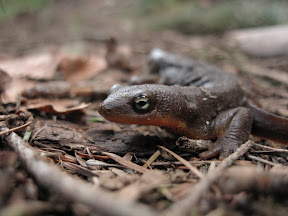 |
| From MattStansberry |
I would have taken a few pics today, but my digital camera is still drying out thanks to my dump in Indian Creek last week.
Speaking of cameras -- I am appealing to the peanut gallery for digital camera advice. I'm literally sitting on about $1000 in broken mid-range digital camera equipment. I have 2 Olympus cameras, one that has a broken cover that slides over the screen)and another that the auto-focus crapped out on. I probably don't have the warranties -- I'm not a paperwork guy. Are these things worth sending back to Olympus for a repair?
Winter steelhead fishing on the Siuslaw River
Winter steelhead fishing on the Siuslaw River above Whitaker Creek yesterday, Wild Bill and I again tried our luck chasing the silver monsters. The river was absolutely jammed when we got there -- tons of wade fishermen, and easily a dozen boats between Whitaker Creek and 126.
We kept going upstream, past the Whitaker Creek boat launch, and the people dropped off to nothing. Where the hell were all the people? We didn’t have our regulations in the car, but our first thought was that the river was closed above Whitaker Creek. We drove back down to the boat ramp to see if we could spot someone official looking to ask.
We found a guy walking back up the road from a pullout downriver. He was wearing all green, so we figured that was a good enough reason to trust him. He said the stream was open for several miles above the ramp. So we went for it.
Bill had rushed out that morning, forgetting his wading boots and his rain jacket, so needless to say, he wasn’t in top shape for the water. He wore his L.L. Bean duck boots over his waders and the rubber bottoms of the boots had the traction of roller skates. But undaunted, we drifted some excellent water.
I couldn’t believe we had the place to ourselves. Deep slots, lots of cover, definitely a fishy spot. Bill hooked up with a trout right away on a nymph w/ egg dropper. A good sign. I was fishing a woolybugger/egg combo under a float.
The rain was coming and going and the water looked milky blue. I thought for sure we were on to something. Or fishing illegally. Eventually I spooked two hens, and I watched them run upriver from a big riffle I was trying to fish.
We left.
Despite going 0-4 on my quest for winter steelhead this month, I have learned a few things:
Don’t fish in rubber boots.
Carry a copy of the regs in your car.
Get out earlier -- especially on the weekends. You’ve got to be in front of the mob to get these winter steelhead to bite.
Work slower. I’m spooking a lot of fish, probably right out from under me. I need to work closer and be more patient.
We kept going upstream, past the Whitaker Creek boat launch, and the people dropped off to nothing. Where the hell were all the people? We didn’t have our regulations in the car, but our first thought was that the river was closed above Whitaker Creek. We drove back down to the boat ramp to see if we could spot someone official looking to ask.
We found a guy walking back up the road from a pullout downriver. He was wearing all green, so we figured that was a good enough reason to trust him. He said the stream was open for several miles above the ramp. So we went for it.
Bill had rushed out that morning, forgetting his wading boots and his rain jacket, so needless to say, he wasn’t in top shape for the water. He wore his L.L. Bean duck boots over his waders and the rubber bottoms of the boots had the traction of roller skates. But undaunted, we drifted some excellent water.
I couldn’t believe we had the place to ourselves. Deep slots, lots of cover, definitely a fishy spot. Bill hooked up with a trout right away on a nymph w/ egg dropper. A good sign. I was fishing a woolybugger/egg combo under a float.
The rain was coming and going and the water looked milky blue. I thought for sure we were on to something. Or fishing illegally. Eventually I spooked two hens, and I watched them run upriver from a big riffle I was trying to fish.
We left.
Despite going 0-4 on my quest for winter steelhead this month, I have learned a few things:
Saturday, February 10, 2007
Wading gear review: Hodgman Wadelite Wader Support Belt
Best purchase ever: Fact, the best buy I've ever made in my fly fishing career was my Hodgman Wadelite Wader Support Belt. I picked it up a few months ago after fishing the Umpqua River with Wild Bill. I'd fallen a few times on that notoriously slippery streambed while we were annoying the summer steelhead. Bill had watched me fill my waders a few times and suggested I buy the belt he was wearing.

Since then the belt has actually helped me stay upright and has kept the river from filling my waders several times.
The wading belt cinches up tigher than the standard belts you get with your wader purchase. And the extra wide back support eases the lower back. When I first moved here I was wading every day. My back woud be kiling me. This belt actually makes it easier to wade, it doesn't hurt at all -- instant yoga.
Product specs: Features nylon coated high density foam construction, web belt with Velcro cinch, dual accessory D-rings, and PVC "no slip" dots on inside to prevent belt from sliding on waist. Cost: $27.99.

Since then the belt has actually helped me stay upright and has kept the river from filling my waders several times.
The wading belt cinches up tigher than the standard belts you get with your wader purchase. And the extra wide back support eases the lower back. When I first moved here I was wading every day. My back woud be kiling me. This belt actually makes it easier to wade, it doesn't hurt at all -- instant yoga.
Product specs: Features nylon coated high density foam construction, web belt with Velcro cinch, dual accessory D-rings, and PVC "no slip" dots on inside to prevent belt from sliding on waist. Cost: $27.99.
Friday, February 09, 2007
Fly fishing Indian Creek
Wild Bill and I took a road trip to Indian Creek today to find fabled winter steelhead. We passed a lot of good looking water on the Siuslaw River on the way there, but we were determined to check out this wader-friendly tributary.
The water has been really low, not good for feisty fish, but it makes fly fishing a little easier. I floated a chenille and chain-bead egg pattern on a Palsa indicator. Wild Bill was throwing a black woolybugger.
I was drifting over some good looking runs, but nothing happening. The water was really clear, tough going for sneaking on the fish. We probably spooked a bunch. But we eventually saw one of the fish we spooked.
It looked about 30 inches from what I saw of it. Wild Bill had a better view. He spooked it from where it was holding at the top of a riffle. It ran down to the sandy bottom of a deep pool, and then he lost track of it.
He spent the rest of the afternoon trying to get it coming back around, but no luck. Spooking a steelhead is a lot like pissing off your girlfriend. No amount of flailing is going to make things go your way. Best to let things calm down and come back later.
There were some really tiny nymphs in the water. I had them all over my hand after climbing over some rocks. I was taking a picture of the nymphs when something popped up in the river in front of me. At first I thought it was a seal. Turned out to be an otter, which was really cool to see. And then I slipped and dunked my camera.
We’ll see if it comes back. I’d like to try to identify those nymphs.
We saw a bald eagle flying over Lake Creek on the way back. It might have been Stephen Jr.
The water has been really low, not good for feisty fish, but it makes fly fishing a little easier. I floated a chenille and chain-bead egg pattern on a Palsa indicator. Wild Bill was throwing a black woolybugger.
I was drifting over some good looking runs, but nothing happening. The water was really clear, tough going for sneaking on the fish. We probably spooked a bunch. But we eventually saw one of the fish we spooked.
It looked about 30 inches from what I saw of it. Wild Bill had a better view. He spooked it from where it was holding at the top of a riffle. It ran down to the sandy bottom of a deep pool, and then he lost track of it.
He spent the rest of the afternoon trying to get it coming back around, but no luck. Spooking a steelhead is a lot like pissing off your girlfriend. No amount of flailing is going to make things go your way. Best to let things calm down and come back later.
There were some really tiny nymphs in the water. I had them all over my hand after climbing over some rocks. I was taking a picture of the nymphs when something popped up in the river in front of me. At first I thought it was a seal. Turned out to be an otter, which was really cool to see. And then I slipped and dunked my camera.
We’ll see if it comes back. I’d like to try to identify those nymphs.
We saw a bald eagle flying over Lake Creek on the way back. It might have been Stephen Jr.
Trout politics: Hard hitting research from Teh Wind Knot
Most of us outdoors bloggers are limited to posting pictures, stories about our weekends, pointing to other peoples' links. But some bloggers out there are publishing actual research. Specifically, two posts on Teh Wind Knot caught my attention this week.
First, if you've been following the public flogging that river-grubbing Spring Ridge Club has been taking the past month, you might be interested to know what kind of people are included in its members ranks. Through some creative search engine tactics, TWK managed to pull together a list that has since been removed from the site.
From TWK: You never know; you might want to switch cardiologists or move your 401(k) to a firm that does not try to steal trout waters from you.
The slimebags at the Spring Ridge Club are a pretty easy target. But what about my beloved Trout Unlimited? I pretty much give that group carte blanche. TWK pulled from his finance know-how to analyze how TU is spending my money and he was less than impressed.
TWK: I can't convince anyone that TU is an efficient organization, since with the most favorable look, only about 20% of annual revenues are spent on fish stuff. It is pretty clear that TU could do more in grassroots habitat work if they cut down on the glossy magazines, direct mail and boondoggles for staffers.
Serious work.
First, if you've been following the public flogging that river-grubbing Spring Ridge Club has been taking the past month, you might be interested to know what kind of people are included in its members ranks. Through some creative search engine tactics, TWK managed to pull together a list that has since been removed from the site.
From TWK: You never know; you might want to switch cardiologists or move your 401(k) to a firm that does not try to steal trout waters from you.
The slimebags at the Spring Ridge Club are a pretty easy target. But what about my beloved Trout Unlimited? I pretty much give that group carte blanche. TWK pulled from his finance know-how to analyze how TU is spending my money and he was less than impressed.
TWK: I can't convince anyone that TU is an efficient organization, since with the most favorable look, only about 20% of annual revenues are spent on fish stuff. It is pretty clear that TU could do more in grassroots habitat work if they cut down on the glossy magazines, direct mail and boondoggles for staffers.
Serious work.
Thursday, February 08, 2007
Coastal Cutthroat bonanza on the fly
I headed west this afternoon to fish a coastal stream (which will remain unnamed), looking for steelhead. It's a river I've been scouting for a little while, waiting to get my license.
I was using my standby, black, size 10 beadhead woolybugger. It wasn't doing much, so I put on a tiny orange nymph float. Soon after, I figured it out -- fish were hitting my orange float.
I switched out to an egg pattern and started catching cuttrhoats on an egg and indicator rig. The first few were tiny, but as I worked upstream to bigger pools I started catching bigger fish in the 14" range.
As it got dark I switched back to my woolybugger so the fish could see it. They started getting more aggressive and taking it on the swing.
They weren't giant winter steelhead, but you know, after catching about 15 of them I lost count.
I was using my standby, black, size 10 beadhead woolybugger. It wasn't doing much, so I put on a tiny orange nymph float. Soon after, I figured it out -- fish were hitting my orange float.
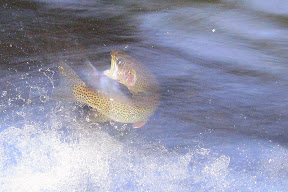 |
| From MattStansberry |
I switched out to an egg pattern and started catching cuttrhoats on an egg and indicator rig. The first few were tiny, but as I worked upstream to bigger pools I started catching bigger fish in the 14" range.
As it got dark I switched back to my woolybugger so the fish could see it. They started getting more aggressive and taking it on the swing.
They weren't giant winter steelhead, but you know, after catching about 15 of them I lost count.
Oregon hunting and fishing dangers
Hunting and fishing in Oregon can be a risky endeavor. Just look at these two recent news stories.
Lead tainted deer
From the Corvallis Gazzette Times, outdoors columnist Bill Barker tells the story of a hunting partner getting sick from eating environmentally tainted deer. A buck his partner had shot had been carrying around many times the normal amount of lead found in animal tissues.
From the article: "It was definitely causing his sickness. Needless to say, he decided to empty his freezer. It took quite a while for him to start feeling better. It’s hard to rid the body of lead."
Barker's party found a lead-polluted stream near their camp site and the vegetation around the area was storing mineral traces. That buck had an appetite for lead-tainted browse.
Rogue waves near Chetco River bar
A story in today's Mail Tribune points out that a new shallow shoal spanning most of Sporthaven Beach is responsible for creating "sneaker" waves that have capsized small boats crabbing 100-200 yards from the beach. Last week 12-foot rogue wave capsized a small craft, drowning one man. It was the second capsize incident in less than a week.
It looks like the Port of Brookings is going to have to change the tagline on its Web site: "The safest bar on the Oregon Coast".
Lead tainted deer
From the Corvallis Gazzette Times, outdoors columnist Bill Barker tells the story of a hunting partner getting sick from eating environmentally tainted deer. A buck his partner had shot had been carrying around many times the normal amount of lead found in animal tissues.
From the article: "It was definitely causing his sickness. Needless to say, he decided to empty his freezer. It took quite a while for him to start feeling better. It’s hard to rid the body of lead."
Barker's party found a lead-polluted stream near their camp site and the vegetation around the area was storing mineral traces. That buck had an appetite for lead-tainted browse.
Rogue waves near Chetco River bar
A story in today's Mail Tribune points out that a new shallow shoal spanning most of Sporthaven Beach is responsible for creating "sneaker" waves that have capsized small boats crabbing 100-200 yards from the beach. Last week 12-foot rogue wave capsized a small craft, drowning one man. It was the second capsize incident in less than a week.
It looks like the Port of Brookings is going to have to change the tagline on its Web site: "The safest bar on the Oregon Coast".
Wednesday, February 07, 2007
Goodman Creek hike
Looking for a hike nearby Eugene yesterday I headed south on Willamette Highway 58 to a trailhead near Hardesty Mt. The 2 mile hike back to the waterfall on Goodman Creek Trail would leave me enough time to get back before dark, so I headed out.
I wasn’t expecting much. Looking at Goodman Creek from the road it’s kind of a wasteland, a dirty stump-filled gulley leading to Lookout Reservoir. Plus, starting out on the trail I realized how busy Rte 58 really is. You could hear the traffic for at least the first mile and a half.
Huge trees were down across the trails and it was pretty slow going at first. Which is lucky because I found an Oregon rough-skinned newt.
I spotted more wildlife at the end of the line at the falls. There was a little charcoal-black water ouzel singing. It would look at me, sing a few lines, and dips under the water. It sounded like a medley of songs from different birds.
The sound of the bird, the falls, the little grotto -- it reminded me of some sort of cheesy waterfall you’d buy at a landscaping store. The overhanging ferns and moss, the glassy pool in no way seems related to the dusty trickle running to the highway.
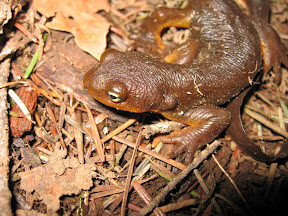 |
| From MattStansberry |
I wasn’t expecting much. Looking at Goodman Creek from the road it’s kind of a wasteland, a dirty stump-filled gulley leading to Lookout Reservoir. Plus, starting out on the trail I realized how busy Rte 58 really is. You could hear the traffic for at least the first mile and a half.
Huge trees were down across the trails and it was pretty slow going at first. Which is lucky because I found an Oregon rough-skinned newt.
 |
| From MattStansberry |
I spotted more wildlife at the end of the line at the falls. There was a little charcoal-black water ouzel singing. It would look at me, sing a few lines, and dips under the water. It sounded like a medley of songs from different birds.
The sound of the bird, the falls, the little grotto -- it reminded me of some sort of cheesy waterfall you’d buy at a landscaping store. The overhanging ferns and moss, the glassy pool in no way seems related to the dusty trickle running to the highway.
First fish of 2007 -- McKenzie River
Wild Bill and I went on the move today to try to find some active trout. I had to stop in Walterville, OR at the McKenzie Angler where they told us upriver was too cold, better off heading back toward town.
We headed downriver to Armitage, parked under the bridge and headed out in the rain. I had a size 10, black beadhead wooly bugger on my four-weight. Not the best choice of rod -- short for the size of the water and a little flimsy for the weight of the fly -- but it’s new and I wanted to use it.
Light drizzle, about 50 degrees, it felt good to be fishing. But I wanted more structure. This run of river was pretty smooth, no pockets or breaks to speak of. Plus, I’d left my polarized glasses at home. Eventually I did find some structure, a drop off along the channel.
I’d like to say I planned on catching the fish on that drop, but I actually hadn’t caught anything and was turning around to talk some smack to Wild Bill when the thing hit my line. It was nothing to brag about -- little wild cutthroat about 10 inches.
Wild Bill got a few hits from fish in the same scale, had one on for a minute. Eventually the little guys started rising. Pretty cool first day back.
We headed downriver to Armitage, parked under the bridge and headed out in the rain. I had a size 10, black beadhead wooly bugger on my four-weight. Not the best choice of rod -- short for the size of the water and a little flimsy for the weight of the fly -- but it’s new and I wanted to use it.
Light drizzle, about 50 degrees, it felt good to be fishing. But I wanted more structure. This run of river was pretty smooth, no pockets or breaks to speak of. Plus, I’d left my polarized glasses at home. Eventually I did find some structure, a drop off along the channel.
I’d like to say I planned on catching the fish on that drop, but I actually hadn’t caught anything and was turning around to talk some smack to Wild Bill when the thing hit my line. It was nothing to brag about -- little wild cutthroat about 10 inches.
Wild Bill got a few hits from fish in the same scale, had one on for a minute. Eventually the little guys started rising. Pretty cool first day back.
Oregon fishing news
More dams coming down, according to an AP report in The Oregonian. Slayden Construction Group was chosen to remove the Chiloquin Dam to open up spawning habitat for endangered suckers in Upper Klamath Lake.
The firm is being paid $9 million to remove the dam, an irrigation diversion built in 1914 on the Sprague River outside the town of Chiloquin. The 11-foot-high dam is scheduled to be removed by the end of 2008.
Other news: In the Register-Guard, Stahlberg points out that weather conditions are driving winter steelheaders nuts (no shit?). Beginning of the run was a sloppy mess, now it's too low and too cold for people. The guides he talks to give some good advice. Worth reading.
Speaking of fishing -- It's official today. Six months. I'm leaving in about a minute to go get my Oregon resident hunting and fishing tags. I'll probably go to the McKenzie later today to try to rustle up some winter trout.
The firm is being paid $9 million to remove the dam, an irrigation diversion built in 1914 on the Sprague River outside the town of Chiloquin. The 11-foot-high dam is scheduled to be removed by the end of 2008.
Other news: In the Register-Guard, Stahlberg points out that weather conditions are driving winter steelheaders nuts (no shit?). Beginning of the run was a sloppy mess, now it's too low and too cold for people. The guides he talks to give some good advice. Worth reading.
Speaking of fishing -- It's official today. Six months. I'm leaving in about a minute to go get my Oregon resident hunting and fishing tags. I'll probably go to the McKenzie later today to try to rustle up some winter trout.
Tuesday, February 06, 2007
Coastal Oregon hikes wrap up
Coastal hikes in brief: After camping at Cape Lookout last weekend we made our way south to Cape Kiwanda -- home of Haystack Rock. We headed out from the parking area into a tire-track rutted beach. But it was fifty degrees and sunny, so I tried not to let it get me down. But then I looked up to my right and saw these massive, nasty condos going up.
They’re calling them “fractional ownership cottages” in a huge multi-page ad in Oregon Coast magazine this month. From my standpoint, it blights an Oregon landmark -- and whatever Pacific City’s economic developers thinks they’re getting out of the deal, it’s probably not worth it.
Despite the nasty McMansions sprawling above us, we moved on to climb the cape for a better view of Haystack Rock. And I can say that after you climbed up the sandstone cliff and looked out over the coast, you could almost forget about Kiwanda Lodge looming behind you.
After that we headed to the Devils Punchbowl. The hike down to the beach was closed, most likely because a storm had ripped the staircase leading down to the beach from its moorings. We ignored the signs and climbed down anyway.
We thought we were being pretty adventurous, until a big family with little kids made it down without the stairs just fine right after us.
The tide was too high to get into the “punchbowl” but I did get pretty close and took a fuzzy picture of some harlequin ducks.
Sunday was a big day for surfers -- we saw them at every stop.
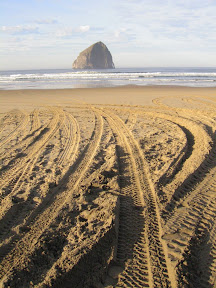 |
| From MattStansberry |
They’re calling them “fractional ownership cottages” in a huge multi-page ad in Oregon Coast magazine this month. From my standpoint, it blights an Oregon landmark -- and whatever Pacific City’s economic developers thinks they’re getting out of the deal, it’s probably not worth it.
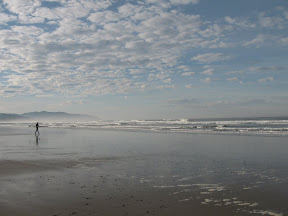 |
| From MattStansberry |
Despite the nasty McMansions sprawling above us, we moved on to climb the cape for a better view of Haystack Rock. And I can say that after you climbed up the sandstone cliff and looked out over the coast, you could almost forget about Kiwanda Lodge looming behind you.
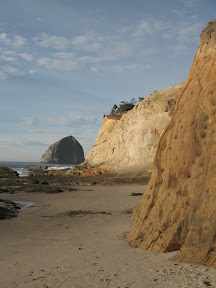 |
| From MattStansberry |
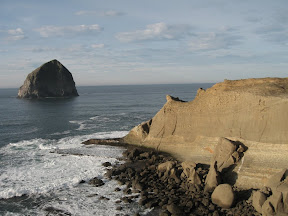 |
| From MattStansberry |
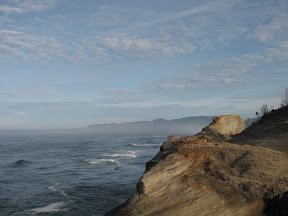 |
| From MattStansberry |
After that we headed to the Devils Punchbowl. The hike down to the beach was closed, most likely because a storm had ripped the staircase leading down to the beach from its moorings. We ignored the signs and climbed down anyway.
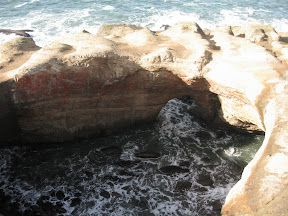 |
| From MattStansberry |
We thought we were being pretty adventurous, until a big family with little kids made it down without the stairs just fine right after us.
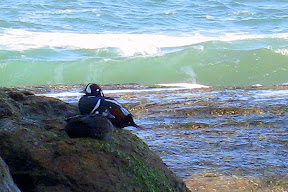 |
| From MattStansberry |
The tide was too high to get into the “punchbowl” but I did get pretty close and took a fuzzy picture of some harlequin ducks.
 |
| From MattStansberry |
Sunday was a big day for surfers -- we saw them at every stop.
Alsea hatchery looking to wild steelhead for brood booster
The Alsea Hatchery is looking for anglers on the Alsea River to participate in the wild winter steelhead brood stock collection project, according to the Corvallis Gazette-Times.
The hatchery supplies collecting equipment to volunteer fishermen for transporting wild steelhead. The hatchery then uses those wild fish to boost its breeding stock.
Generally, I'm against this for a couple reasons. One, it's taking naturally reproducing wild fish out of the system. Two, it perpetuates the idea that hatcheries are a valid response to environmentally damaged watersheds.
Hatcheries are a band-aid solution. ODFW funds would be better spent restoring naturally reproducing fish. But that's pretty hard work. More fish in the creel translates into more licenses bought, therefore more money for ODFW.
If any of you hatchery-heads out there have a counter argument I'd like to hear it. I'm going to be open, because I like lots of big dumb fish as much as the next guy. And I like catching stocked fish in Oregon's high lakes.
For Trout Unlimited's anti-hatchery response, check out their Why Wild campaign.
The hatchery supplies collecting equipment to volunteer fishermen for transporting wild steelhead. The hatchery then uses those wild fish to boost its breeding stock.
Generally, I'm against this for a couple reasons. One, it's taking naturally reproducing wild fish out of the system. Two, it perpetuates the idea that hatcheries are a valid response to environmentally damaged watersheds.
Hatcheries are a band-aid solution. ODFW funds would be better spent restoring naturally reproducing fish. But that's pretty hard work. More fish in the creel translates into more licenses bought, therefore more money for ODFW.
If any of you hatchery-heads out there have a counter argument I'd like to hear it. I'm going to be open, because I like lots of big dumb fish as much as the next guy. And I like catching stocked fish in Oregon's high lakes.
For Trout Unlimited's anti-hatchery response, check out their Why Wild campaign.
Oregon natural history blog
I usually just rely on my Links list to the right hand side of the page there to guide people to sites I like, but this site deserves special recommendation. If you are at all interested in Oregon natural history or great outdoor photography, you need to check out Dzonoqua's Whistle.
Meet the cougar tree while you're there:

Meet the cougar tree while you're there:

Monday, February 05, 2007
Cape Lookout campground
I like telling people that KP and I were camping last weekend. Makes us sound hardcore. But we were staying in a yurt. Which is actually an acronym for Year-round ...Uhhh Recrational Tent. For a more thorough discussion of yurt-ness, see a previous post on Valley of the Rogue State Park and its lovely yurts.
We pulled into the Cape Lookout State Park campground around 3:00 pm. The camp host, an older guy in a green hat with an Oregon State Parks Volunteer patch attached to it, wasn’t happy about letting us in our yurt an hour early. He told us not to try to pull that kind of crap in the summer because it wouldn’t work.
He also stearnly warned us about the no dogs policy (Where the hell would I be hiding a dog in my Honda Civic?). Nonetheless he was doing his job. You have to stay on top of people. These campgrounds are mobbed by unruly senior citizens all summer -- give em an inch and they'll take a mile.
I thought the Cape Lookout campground was a lot prettier, wilder and more secluded than the Valley of the Rogue, which seemed like a golf course taken over by an RV-jamboree. This campsite was more wooded, less crowded and close to the action.
We made the run down to the beach, a short walk from the camping area, and found sand dollars and jellyfish. When we got back we could still hear the surf inside the yurt while we were muching on yuppie food: Trader Joe trail mix, green tea, Cheez-its.
After dark we headed toward Netarts and had dinner at The Schooner, a great little place with hand-tossed brick oven pizzas and homegrown oysters. No Web site for The Schooner, but you can reach them at (503) 815-9900.
The camp site is in a good location to check out the Three Capes scenic area: Cape Meares, Cape Lookout and Cape Kiwanda.
We pulled into the Cape Lookout State Park campground around 3:00 pm. The camp host, an older guy in a green hat with an Oregon State Parks Volunteer patch attached to it, wasn’t happy about letting us in our yurt an hour early. He told us not to try to pull that kind of crap in the summer because it wouldn’t work.
He also stearnly warned us about the no dogs policy (Where the hell would I be hiding a dog in my Honda Civic?). Nonetheless he was doing his job. You have to stay on top of people. These campgrounds are mobbed by unruly senior citizens all summer -- give em an inch and they'll take a mile.
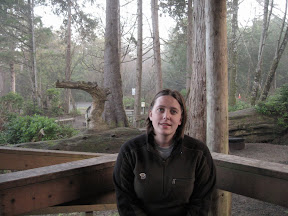 |
| From MattStansberry |
I thought the Cape Lookout campground was a lot prettier, wilder and more secluded than the Valley of the Rogue, which seemed like a golf course taken over by an RV-jamboree. This campsite was more wooded, less crowded and close to the action.
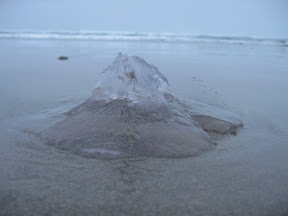 |
| From MattStansberry |
We made the run down to the beach, a short walk from the camping area, and found sand dollars and jellyfish. When we got back we could still hear the surf inside the yurt while we were muching on yuppie food: Trader Joe trail mix, green tea, Cheez-its.
After dark we headed toward Netarts and had dinner at The Schooner, a great little place with hand-tossed brick oven pizzas and homegrown oysters. No Web site for The Schooner, but you can reach them at (503) 815-9900.
The camp site is in a good location to check out the Three Capes scenic area: Cape Meares, Cape Lookout and Cape Kiwanda.
Cape Lookout hike
KP and I set out from Portland Saturday morning, headed for the coast and Cape Lookout State Park. After spending a regrettable hour or so in Tillamook (both the creamery tour and breakfast in town were a little disappointing -- not terrible, but don't plan your day around it is all I'm saying), we continued westward to the coast.
When we got to the park there were three options at the main trailhead: South along the beach, straight out onto the peninsula and north toward the camp. We took the middle option: Cape Lookout -- 2.4 miles into the Pacific. According to Bill Sullivan, this cape was formed by a river of lava rolling down from the Cascades to the sea. You could tell, sharp volcanic rocks jutted out from the beaten trail and tried to grab your ankles.
The view to the south was great from the very beginning -- Haystack rock was off on the horizon. Not close enough to make a good landscape shot, but still nice to look at. There wasn’t much of a payoff at the end of the Cape. The view didn’t get any better.
That is probably a sign that I’m not a real hiker. All of my hiking has to be goal or rewards based. I need a viewpoint, a summit, a lake, something. That’s why I take photos constantly, or geocache -- or walk fast and call it a workout, a way to break in gear.
Too much Type A personality in my DNA. Maybe Oregon will eventually help leech that out of me.
Walking the trail we were both quiet, but my brain started channeling the late 1990s. Snippets of songs running through my head. Bad songs: Too legit to quit, from MC Hammer; Knockin’ on heaven’s door, Guns and Roses version. And it wasn’t even the real songs that were playing, more like a karaoke version.
The brain doesn’t like silence.
I wouldn’t have noticed it, except that I’d read about John Daniel doing it in his book Rogue River Journal. It's a book about an experiment in wildernes isolation, among other things. I'm hoping to review it ASAP.
On the way back from the tip of the point we started looking for a geocache. My Garmin eTrex Legend was performing particularly well at the time and pointed us right to it. The owner of the Geocache had written extensive directions about the cache, but I didn’t want it to be too easy so I didn’t read the whole thing. Usually that results in me and KP stumbling around in a 30-foot radius and sifting leaf litter, turning over rocks, bushwhacking through shrubbery and not finding anything. But this time it worked out Ok.
We found the black box under a log, just about 10 feet off the trail. The scrub was beaten down leading us right to it. We signed the log and put it back. There were some cool things in there, specifically a mini first aid kit. But we left it and everything else.
We did see some seabirds and a big pod of sea lions stacked up in a group on the south side of the cape. No whales though. Supposedly they migrate through the area in the winter and spring and they have to swim around the point.
There were a ton of trees down on the trail. Whoever maintains the trails had already come through and sawed them up, pushed the trunks to the side. I have to imagine it was from the storm several weeks ago. The ocean was relatively calm and the wind was really ripping up there. I can’t imagine what it’s like in a storm.
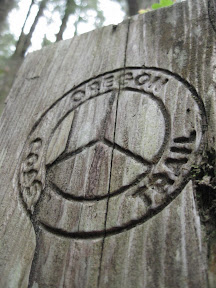 |
| From MattStansberry |
When we got to the park there were three options at the main trailhead: South along the beach, straight out onto the peninsula and north toward the camp. We took the middle option: Cape Lookout -- 2.4 miles into the Pacific. According to Bill Sullivan, this cape was formed by a river of lava rolling down from the Cascades to the sea. You could tell, sharp volcanic rocks jutted out from the beaten trail and tried to grab your ankles.
The view to the south was great from the very beginning -- Haystack rock was off on the horizon. Not close enough to make a good landscape shot, but still nice to look at. There wasn’t much of a payoff at the end of the Cape. The view didn’t get any better.
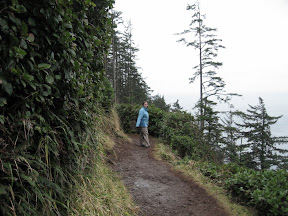 |
| From MattStansberry |
That is probably a sign that I’m not a real hiker. All of my hiking has to be goal or rewards based. I need a viewpoint, a summit, a lake, something. That’s why I take photos constantly, or geocache -- or walk fast and call it a workout, a way to break in gear.
Too much Type A personality in my DNA. Maybe Oregon will eventually help leech that out of me.
 |
| From MattStansberry |
Walking the trail we were both quiet, but my brain started channeling the late 1990s. Snippets of songs running through my head. Bad songs: Too legit to quit, from MC Hammer; Knockin’ on heaven’s door, Guns and Roses version. And it wasn’t even the real songs that were playing, more like a karaoke version.
The brain doesn’t like silence.
I wouldn’t have noticed it, except that I’d read about John Daniel doing it in his book Rogue River Journal. It's a book about an experiment in wildernes isolation, among other things. I'm hoping to review it ASAP.
On the way back from the tip of the point we started looking for a geocache. My Garmin eTrex Legend was performing particularly well at the time and pointed us right to it. The owner of the Geocache had written extensive directions about the cache, but I didn’t want it to be too easy so I didn’t read the whole thing. Usually that results in me and KP stumbling around in a 30-foot radius and sifting leaf litter, turning over rocks, bushwhacking through shrubbery and not finding anything. But this time it worked out Ok.
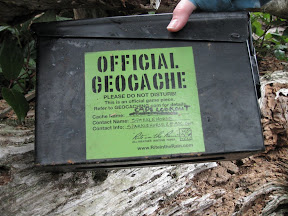 |
| From MattStansberry |
We found the black box under a log, just about 10 feet off the trail. The scrub was beaten down leading us right to it. We signed the log and put it back. There were some cool things in there, specifically a mini first aid kit. But we left it and everything else.
We did see some seabirds and a big pod of sea lions stacked up in a group on the south side of the cape. No whales though. Supposedly they migrate through the area in the winter and spring and they have to swim around the point.
There were a ton of trees down on the trail. Whoever maintains the trails had already come through and sawed them up, pushed the trunks to the side. I have to imagine it was from the storm several weeks ago. The ocean was relatively calm and the wind was really ripping up there. I can’t imagine what it’s like in a storm.
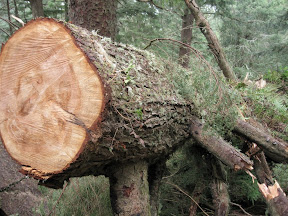 |
| From MattStansberry |
Sunday, February 04, 2007
Osprey gear review
Saturday I took my new backpack for a test run on the Cape Lookout trail. It was a nice windy slog on the coast through Sitka Spruce and Western Hemlock on a volcanic ridge jutting out into the Pacific Ocean.

When I got to the end of the trail I met a couple of hikers that worked for an agriculture dept in Tillamook and we talked about packs for a bit. I was humping my Osprey Atmos 65, loaded with about 25 pounds of gear. The guys oohed and ahhed about my pack, too polite to make any criticisms, but I’ll lay out a couple here.
First, I don’t like the bottom chamber. I bought it in a bit of a rush (on a lunch break) and hadn’t noticed that the bag wasn’t a single stuff pack. It has a bottom compartment that zips open for you to put your sleeping bag in. I’ve got an old sleeping back and it doesn’t fit. It probably means I need a new sleeping bag, but I still didn’t like it. The bag makes you pack the way it wants you to, and zippers leak.
Second, it rode a little high on my hips, seeming to move up as I walked. I did some adjusting to make it fit better, loosening the shoulder straps, tightening the sternum. There are probably some things I could do with the internal frame. I’ll have to check that out.
The mesh back panel design was meant to keep the pack off of my back, giving my skin some room to breathe, but I was still sweating even stripped down to my base layer. Still, I think it’s a cool idea and it’s really comfortable.
All in all I think it’s a good pack. But maybe that’s because I spent the cash already. Regardless, I did 5 miles with 25 pounds and had zero strain or pain. I need to spend more time learning how to pack it better.
Osprey Atmos 65 Specs
Cubic inches: 4,000
Liter 65
Weight 3lbs 10oz
Max recommended carrying weight 45lbs
Removable Sleeping Pad Straps
Water Resistant Zippers
Cost: $229.

When I got to the end of the trail I met a couple of hikers that worked for an agriculture dept in Tillamook and we talked about packs for a bit. I was humping my Osprey Atmos 65, loaded with about 25 pounds of gear. The guys oohed and ahhed about my pack, too polite to make any criticisms, but I’ll lay out a couple here.
First, I don’t like the bottom chamber. I bought it in a bit of a rush (on a lunch break) and hadn’t noticed that the bag wasn’t a single stuff pack. It has a bottom compartment that zips open for you to put your sleeping bag in. I’ve got an old sleeping back and it doesn’t fit. It probably means I need a new sleeping bag, but I still didn’t like it. The bag makes you pack the way it wants you to, and zippers leak.
Second, it rode a little high on my hips, seeming to move up as I walked. I did some adjusting to make it fit better, loosening the shoulder straps, tightening the sternum. There are probably some things I could do with the internal frame. I’ll have to check that out.
The mesh back panel design was meant to keep the pack off of my back, giving my skin some room to breathe, but I was still sweating even stripped down to my base layer. Still, I think it’s a cool idea and it’s really comfortable.
All in all I think it’s a good pack. But maybe that’s because I spent the cash already. Regardless, I did 5 miles with 25 pounds and had zero strain or pain. I need to spend more time learning how to pack it better.
Osprey Atmos 65 Specs
Friday, February 02, 2007
February PDX 07
After spending six months in Oregon, I've finally made my first recreational trip to Portland. It's not a bad town, I just hate I-5 too much to come up here often. This pic is from the Chinese Gardens.
I made a stop at Powell's tonight and picked up some new books to review for OOJ. More details on that later.
Tomorrow it's Tillamook or bust. We're hiking Cape Lookout and staying in a yurt. I'll be trying out my new Atmos 65 and geocaching. We're looking for GC9311.
I'll let you know how it works out.
Medford, OR fly shop promotes gratuitous fish porn
Thanks to Moldy Chum, I found myself clicking through the winter steelhead hero shots on the Trophy Waters Fly Fishing Shop's online photo album. Check out this cutt:

The countdown is on: Five more days until I am officially an Oregon resident (six months) and I can go buy my '07 permits. If you've seen an inordinate amount of hiking posts between Jan 1 and now, that's why.

The countdown is on: Five more days until I am officially an Oregon resident (six months) and I can go buy my '07 permits. If you've seen an inordinate amount of hiking posts between Jan 1 and now, that's why.
Freak salmon on the Rogue River
When Jack Burns of Medford, OR hooked into a 30-lb fish on the Rogue River last week, he was pretty sure he was going in the record books for a monster winter steelhead. But when the fish came to the net, Burns had something entirely different on his hands, a freak Chinook salmon. Spring chinook aren't due to run in Oregon for another month, while the fall run happened months ago. The likely origin of this lost salmon is the Sacramento River basin -- an unusual run of rare "winter" chinook. The Mail Tribune has the full story.
Thursday, February 01, 2007
Trout Unlimited pumped up about Farm Bill
Trout Unlimited applauded Agriculture Secretary Mike Johanns yesterday for an increase in conservation funding in the Farm Bill by $7.8 billion, almost tripling existing funds.
Yesterday’s announcement also included a proposed Regional Water Enhancement Program, which would invest $175 million annually to support projects that improve water quality and increase stream flows.
Here is the full TU response to the Farm Bill.
Yesterday’s announcement also included a proposed Regional Water Enhancement Program, which would invest $175 million annually to support projects that improve water quality and increase stream flows.
Here is the full TU response to the Farm Bill.
More dead sea lions on Oregon beaches
Leave those dead/dying sea lions alone, say experts from Oregon State University in an Associated Press report from today's Seattle Times. More of these animals are washing up on Oregon beaches than usual, thanks to an increased sea lion population, gun shot wounds from angry fishermen and a bacteria called Leptospirosis that is potentially harmful to humans. The disease has shown up in roughly 1/3 of the dead animals.
Fishermen are blamed for a significant amount of sea lion deaths because sea lions steal hooked salmon. Last November I almost tripped over a dying sea lion that had been shot in the back while I was walking along the Sixes River at Cape Blanco. See below:
For more info, check out the Marine Mammal Stranding Network.
Fishermen are blamed for a significant amount of sea lion deaths because sea lions steal hooked salmon. Last November I almost tripped over a dying sea lion that had been shot in the back while I was walking along the Sixes River at Cape Blanco. See below:
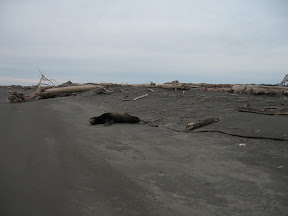 |
| From MattStansberry |
For more info, check out the Marine Mammal Stranding Network.
Subscribe to:
Posts (Atom)
